Aircraft sortie rates
First of all we’d like to use the opportunity to thank everyone who have contributed to the aircraft sortie rate discussions since the early 1990s. Your input has been a tremendous help pointing us in the right direction, enabling us to implement a highly realistic sortie rate model for the Command: Modern Air / Naval Operations simulator.
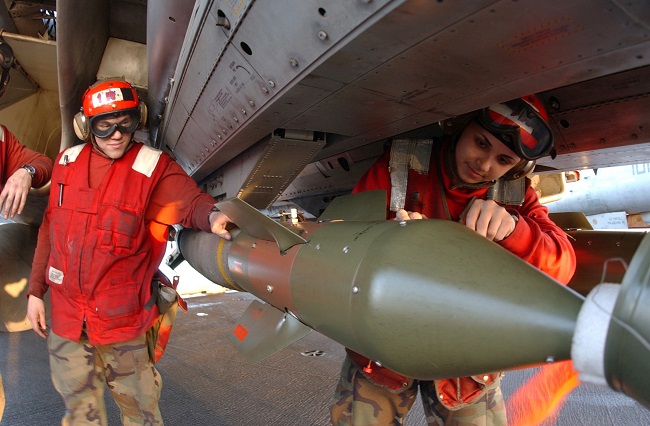
Table of Contents
Introduction
Harpoon Classic: air hyperactivity & unlimited munitions
Harpoon 2: air hyperactivity & munitions limitations
Harpoon 3: Custom Ready Times
Command: Identifying the next logical step
Air Operations Tempo
Surge Operations Vs. Sustained Operations
Scenario design: setting up a squadron for Surge Ops
Scenario design: setting up a squadron for Sustained Ops
Alpha Strikes
Quick Turnaround
Limiting Factors
Typical ready times and airborne times
Doctrine Settings
Manually configuring the number of sorties to fly
Backwards Compatibility
Scenario design: Persian Gulf War (1991) – Close Air Support using A-10A Thunderbolt II
Scenario design: Six-Day War (1967) – Operation Moked (airbase interdiction) and CAS
Scenario design: Yom Kippur War (1973) – Day 1 CAS, Day 2 air superiority strikes and CAS
Both, neither, either: Tempo & Turnaround
Tempo: Surge Operations – Quick Turnaround: Fighters and ASW
Tempo: Surge Operations – Quick Turnaround: Enabled
Tempo: Sustained Operations – Quick Turnaround: Enabled
Tempo: Sustained Operations – Quick Turnaround: Disabled
Sortie Rate Factors
To those that refuse to understand
An Ongoing Endeavor
Stories
USS Enterprise vs USS Ranger, 1982
Air Operations at RNAS Yeovilton
1967 Six-Day War: Israel vs Egypt, Syria and Jordan
1973 Yom Kippur War: Israel vs Egypt and Syria
Recommended Articles
Frequently Asked Questions
What is a ‘sortie’?
What does ‘sortie rate’ mean?
What is an ‘Alpha Strike’?
I do not agree with the ready times in Command. What can I do about it?
Introduction
The heated aircraft sortie rates discussion started more than two decades ago with Command: Modern Air / Naval Operations‘ predecessor, Larry Bond’s Harpoon-series of naval warfare games. In order to understand this subject and the years of research that has gone into it by the Command developers it might be a good idea to look at how aircraft ready times and logistics modeling have evolved from the initial computer version of Harpoon to the very latest CMANO upgrade.
Harpoon Classic: aircraft hyperactivity & unlimited munitions
When computer Harpoon was first released in December 1989, all aircraft had an arbitrary setting of 30 minutes turn-around time regardless of weapon loadout. This was a fundamentally flawed approach that would plague the game for the next 15 years.
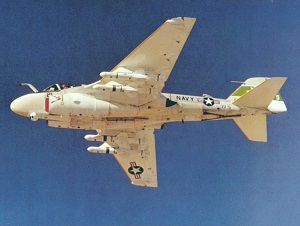 The 30-minute setting was absurdly small for most missions that require significant pre-flight preparation. This was particularly true for strike/bombing missions where attention and effort must be dedicated to the coordination with other cooperative elements such as fighter escorts, airborne early warning, electronic warfare and SEAD. The result was that aircraft became too omni-present and too omnipotent for other scenario units like ships, subs and land units to matter.
The 30-minute setting was absurdly small for most missions that require significant pre-flight preparation. This was particularly true for strike/bombing missions where attention and effort must be dedicated to the coordination with other cooperative elements such as fighter escorts, airborne early warning, electronic warfare and SEAD. The result was that aircraft became too omni-present and too omnipotent for other scenario units like ships, subs and land units to matter.
It should be remembered here that Harpoon was intended to be a wargame of modern combined tactical/operational air & naval warfare, not Flight Commander (as an example) with a naval element strapped-in as an afterthought. But the unrealistic air-hyperactivity combined with unlimited aircraft weapons made airpower a near-invincible tool. The outcome of almost all scenarios were determined on which side had the most formidable air assets. A common Blue-side tactic was to simply shuttle your carrier-borne strikers back and forth in a “take off – get to launch distance – launch Harpoons – get back to carrier” cyclic motion until the Red CVBG/SAG ran out of surface-to-air missiles (SAMs) and countermeasures. No real strategy, no real effort, no complex time-on-target planning or attempt for a surprise attack or a multi-axis saturation, just a pre-determined exercise in attrition. One could almost lay back and calculate when his air assets would break through the defenses.
The same held true for the Red side. In scenarios where the Soviets had lots of missile-armed naval bombers and some good escorts they could simply do the “take off – launch stand-off ASMs – land” dance all day long. This essentially meant that the side with the stronger air assets would win almost every time.
Developer’s note! While many airpower enthusiasts may find nothing abnormal to this result, actual combat operations have proven differently. Air power effectiveness, though significant, has often been inflated to mythic proportions. More on that below.
Harpoon 2: air hyperactivity & munitions limitations
In Harpoon 2 (and by extension, early versions of Harpoon 3) this situation was partially remedied by enabling aircraft logistics. This optional (and buggy) feature limited the ordnance available to air assets. It thus solved the unfair situation of unlimited airborne weapons versus finite surface-borne weapons (SAMs and decoys). However, while this improvement to some extent eliminated the attrition mindset, it still did not solve the problem that, even with limited ammo, aircraft still remained hyperactive and would quickly dominate a scenario. This had two implications:
- The frantic “take off – launch missiles – land” dance of Harpoon Classic continued, the difference now being that at some point the aircraft would eventually stop when running out of weapons. But there was nothing that would prevent the player from continuing the bombardment by switching weapons from high-end missiles to lower-end laser-guided bombs (LGBs) and eventually iron bombs.
- It was almost impossible for surface assets (land & sea) to avoid being monitored by reconnaissance aircraft almost continuously – in real life it is perfectly feasible to avoid both aircraft and satellite surveillance, simply exploiting the gaps in their availability.
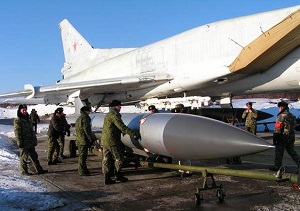 Airpower, while great for delivering ordnance, is not limited to the strike role: equally useful are its surveillance and reconnaissance capabilities, and these are limited by sortie rates, not by ammo figures. Thus the aircraft logistics option did not prevent air assets from having an unrealistically high “time in the air” and providing much more complete area coverage than they would do in real-life operations: For example, with two or three Tu-95RT Bear-D aircraft, and with the standard 30-min turn-around time, the Soviet player could be guaranteed virtually round-the-clock coverage of a general sea area. In reality, even with 30 such precious aircraft, plus a very elaborate network of shore-based HF/DF stations, sea-going SIGINT spy-trawlers (AGIs), HUMINT assets, tattle-tale destroyers and even satellites, the Soviet Navy still had considerable coverage gaps even close to its operating areas, gaps which could be exploited.
Airpower, while great for delivering ordnance, is not limited to the strike role: equally useful are its surveillance and reconnaissance capabilities, and these are limited by sortie rates, not by ammo figures. Thus the aircraft logistics option did not prevent air assets from having an unrealistically high “time in the air” and providing much more complete area coverage than they would do in real-life operations: For example, with two or three Tu-95RT Bear-D aircraft, and with the standard 30-min turn-around time, the Soviet player could be guaranteed virtually round-the-clock coverage of a general sea area. In reality, even with 30 such precious aircraft, plus a very elaborate network of shore-based HF/DF stations, sea-going SIGINT spy-trawlers (AGIs), HUMINT assets, tattle-tale destroyers and even satellites, the Soviet Navy still had considerable coverage gaps even close to its operating areas, gaps which could be exploited.
Harpoon 3: Custom Ready Times
By the time Harpoon had reached its third generation it was time to tackle the fundamental problem of unrealistic aircraft availability. A way to show the end-business difference between a hangar-queen and a mud-fighter. A way to show why many aircraft designers go to extraordinary lengths and make important performance sacrifices in their designs in order to make them more serviceable/maintainable. And a way to show how many “invisible” factors like ground-crew proficiency, base ground equipment, airframe/systems complexity and built-in maintainability features can critically affect the end result: how often the aircraft will be “up there”, doing their job.
In the discussions between the Harpoon 3 developer Jesse Spears and members of the HarpoonHQ.com website (now WarfareSims.com, developer of Command: Modern Air / Naval Operations), it became evident that simply assigning a unique ready-time for each aircraft would not suffice. This is because the very same aircraft can have drastically different preparation times depending on its mission. It is not simply a matter of physically preparing the aircraft itself for the mission: depending on the task, the crews must rest, be briefed (often a protracted event!), coordinate their activities with other assets for the same package etc. Therefore, having just one figure for each aircraft would end up being too simple.
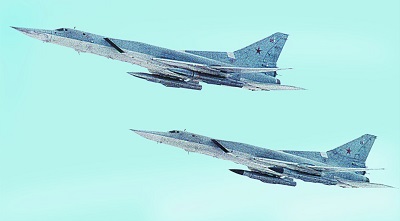 A more elegant solution was to base the ready-time on the loadout selected for the aircraft, and thus indirectly the mission role that was reflected by the loadout stores. In all versions of computer Harpoon (and also in Command), each aircraft had several pre-defined loadouts available. Each of them was a different predefined package of weapons, sensor & jammer pods, and drop tanks, and represents a different mission type. For example, one loadout might be heavy on air-to-air armament and represent a typical CAP load, another might emphasize long range and precision strike capability (PGMs and fuel tanks), yet another may go all-out on short-range CAS (rockets and cluster bombs on all racks). It was therefore fairly straightforward to determine the mission that an aircraft is destined for, by checking on the loadout configuration. It thus made good sense to base the ready-time on the loadout itself.
A more elegant solution was to base the ready-time on the loadout selected for the aircraft, and thus indirectly the mission role that was reflected by the loadout stores. In all versions of computer Harpoon (and also in Command), each aircraft had several pre-defined loadouts available. Each of them was a different predefined package of weapons, sensor & jammer pods, and drop tanks, and represents a different mission type. For example, one loadout might be heavy on air-to-air armament and represent a typical CAP load, another might emphasize long range and precision strike capability (PGMs and fuel tanks), yet another may go all-out on short-range CAS (rockets and cluster bombs on all racks). It was therefore fairly straightforward to determine the mission that an aircraft is destined for, by checking on the loadout configuration. It thus made good sense to base the ready-time on the loadout itself.
Robbing Harpoon’s aircraft of their hitherto omnipotence had drastic repercussions on playing the wargame itself. Here is a sample of some of the effects on how the simulation interacts with the user’s actions & decisions:
- Aircraft that sacrificed performance in order to improve their uptime & availability are now finally being vindicated. Watch simple aircraft as the Harrier, Su-25 Frogfoot or A-10A Thunderbolt II roam over the battlefield repeatedly while their more capable, more sophisticated jets make an occasional and long-awaited appearance, displaying their unique abilities before again withdrawing to their hangars. Heavy long-range combat aircraft in particular , as well as special-mission and electronic-reconnaissance aircraft, now finally get the “silver bullet” treatment they deserve.
- The vastly reduced sortie-rate of most aircraft, combined with the finite scenario duration time, means that players now have much fewer available aircraft sorties in total. This simulates reality and poses a greater challenge in play. Once committed to action, the player will be unable to use those air assets for next several hours or even days. Therefore, he must make more responsible use of air assets in order to succeed: the margins for errors have just shrunk dramatically. Defensive CAPs now have to be planned with greater care, allowing for cross-coverage between successive screens and maybe even hot-pad reinforcements ready to surge. Likewise, offensive missions have to be planned very carefully, with a renewed emphasis on catching the adversary off-guard and overwhelming him with multi-axis attacks rather than with brute-force repeated visits, as was the case in the past. In some air ops-centered scenarios with very tight time limits (such as Steve Le Blanc’s “Operation Babylon”), failure in the first attempt may well not be an option anymore.
- Numerous old Harpoon scenarios suddenly became attractive to play again. Too many scenarios were unbalanced because of one or the other side having a decisive airpower edge which, because of the omnipotence of aircraft, translated into an easy victory. It was time to dust-off some of the goldie oldies and see why the scenario designers bothered to put those subs and surface ships in there as well.
- With the gaps between aircraft availability now getting close to their real-life values, one had to be much more careful about covering his air assets while they’re on the ground (or on the deck). Pearl Harbor, Midway and the start of the Six-Day War are three of the numerous examples of an air force being caught quite literally with its pants down. Now it can happen to you too, so keep your guard up. This also has the implication that a decisive “first strike” is going to regain its importance at the expense of mindless attrition tactics.
- Not doing the “land-arm-launch” dance every half-hour means having time to plan the overall strategy better, maneuvering the non-air assets, checking one’s forces for damages/casualties from the last clash (a tricky thing in large scenarios), preparing the surviving forces better, replenishing and re-supplying the surface/sub forces etc. In short, it means having an overall better and more realistic wargaming experience.
So far so good, but there was one last obstacle to overcome: the players. The aircraft ready times were based on actual wartime sortie rates, not the theoretical minimum time it would take to mount a few bombs and prepare an aircraft and its crew for a given mission. This subtle difference was the source of considerable misunderstanding in various discussions between members of the Harpoon community.
Command: Identifying the next logical step
Building on their past experience with Harpoon, the Command development team adopted the Custom Ready Times concept that they had successfully introduced to Harpoon 3. However, while putting a damper on air-hyperactivity, there were still holes in the model that the Command developer wanted to address in the new simulator.
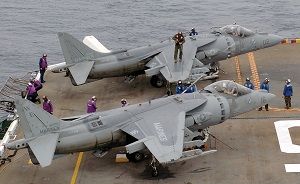 In the USAF in the mid 1980s, it was normal to allow three hours for four men to load and refuel an F-16A with iron bombs for a ground strike. But the same could be done during simulated wartime conditions in 30 minutes or less while wearing full MOPP gear in 115 degree F heat. AV-8B Harrier IIs flying simple CAS missions demonstrated the ability to hit a target repeatedly at 30 minute intervals when operating from forward operating locations, where as the same aircraft integrated into an Air Tasking Order (ATO) of sustained operations would usually not fly more than one sortie per day. In the opening phases of a high-intensity war, strike aircraft would surge at 2.0 sorties per aircraft per day. After 3-5 days the tempo slows down due to wear and tear on men and machines, and sortie rates drop to 1.0 or less.
In the USAF in the mid 1980s, it was normal to allow three hours for four men to load and refuel an F-16A with iron bombs for a ground strike. But the same could be done during simulated wartime conditions in 30 minutes or less while wearing full MOPP gear in 115 degree F heat. AV-8B Harrier IIs flying simple CAS missions demonstrated the ability to hit a target repeatedly at 30 minute intervals when operating from forward operating locations, where as the same aircraft integrated into an Air Tasking Order (ATO) of sustained operations would usually not fly more than one sortie per day. In the opening phases of a high-intensity war, strike aircraft would surge at 2.0 sorties per aircraft per day. After 3-5 days the tempo slows down due to wear and tear on men and machines, and sortie rates drop to 1.0 or less.
So which model do you use? How do you allow some aircraft in certain conditions to fly multiple short-range sorties in quick succession and then step down for prolonged periods? How do you account for the sharp drop in sortie rates when an operation goes from surge to sustained tempo? How do you develop a model that minimizes the grey area between realism and the practical implementation of real life? How much realism can you realistically add to a commercially available simulator?
Unfortunately, true realism is impossible unless you’re actually managing the air element of a carrier battle group. And the Command development team eventually came to realize there is a point where the simulator becomes so complex it will be pretty much unplayable. Accurately modeling aircraft ready times through each of the countless variables that affect air operations would be a tremendous undertaking for the developer, scenario designers and players alike; pilot and ground crew availability, aircraft MMH/FH (Maintenance Man Hours per Flight Hour), training levels, availability of munitions and equipment, weather, operational tempo, defensive posture, etc. And even then, with all variables in place and tweaked to death, the end result might still not match real life experience.
 So rather than looking at each variable influencing sortie rates and trying to simulate those, the Command team decided to simulate the net result of the variables. Which basically is the same model that was developed for Harpoon 3 many years earlier. So maybe the Harpoon3 implementation was good enough? The ready times were pretty much geared towards surge operations for strike aircraft (typically two sorties per aircraft per day on average) since that was the operational tempo most scenarios were designed for. And to be truthful, the game produced fairly realistic sortie rates for strike aircraft in the opening phases of a high-intensity conflict. However, Harpoon 3 lacked the flexibility to switch to sustained operations (one or less sortie per aircraft per day), nor could it handle CAS aircraft doing multiple time-critical sorties in quick succession and then stand down for prolonged periods.
So rather than looking at each variable influencing sortie rates and trying to simulate those, the Command team decided to simulate the net result of the variables. Which basically is the same model that was developed for Harpoon 3 many years earlier. So maybe the Harpoon3 implementation was good enough? The ready times were pretty much geared towards surge operations for strike aircraft (typically two sorties per aircraft per day on average) since that was the operational tempo most scenarios were designed for. And to be truthful, the game produced fairly realistic sortie rates for strike aircraft in the opening phases of a high-intensity conflict. However, Harpoon 3 lacked the flexibility to switch to sustained operations (one or less sortie per aircraft per day), nor could it handle CAS aircraft doing multiple time-critical sorties in quick succession and then stand down for prolonged periods.
So it was clear that Harpoon3 lacked two key features:
- Surge Vs. Sustained Operations: It was time to move away from the single per-loadout ready time figure introduced in Harpoon3. Although the ready time data would still be entered in the database, the player should be able to select either ‘surge operations’ (typically 2.0 sorties per aircraft per day on average) or ‘sustained operations’ (0.7-1.1 sorties). The tempo should be a doctrine setting, which allows the scenario designer to hard-code the tempo and prevent the player from changing it during gameplay, or it can be made editable and so that the player can set the tempo per side, per mission, per naval group / air base, or per unit.
- Quick Turnaround: the Israeli Air Force’s ability to produce Close Air Support (CAS) sorties and the quick turnaround capabilities of the A-10A Thunderbolt II and AV-8B Harrier II flying from forward operating bases is an important capability that simply could not be overlooked. In these cases the typical six-hour ready times become a little artificial. They are meant to take into account things like pilot rest, planning/briefing and aircraft maintenance. But an AV-8B Harrier II that flies several short CAS mission in a row, using the same flight plan and same FAC (Forward Air Controller), with only 20 minute transit time, 10 minutes over target, and returning home within an hour, are regularly turned around faster. Just refuel and mount a few dumb bombs, and the aircraft is ready. This quick turnaround capability would be a nice thing to have, especially since all research so far has been devoted to things which can decrease sortie rates, versus what can increase them.
The next logical step for Command: Modern Air / Naval Operations had been identified, and it was time to get to work.
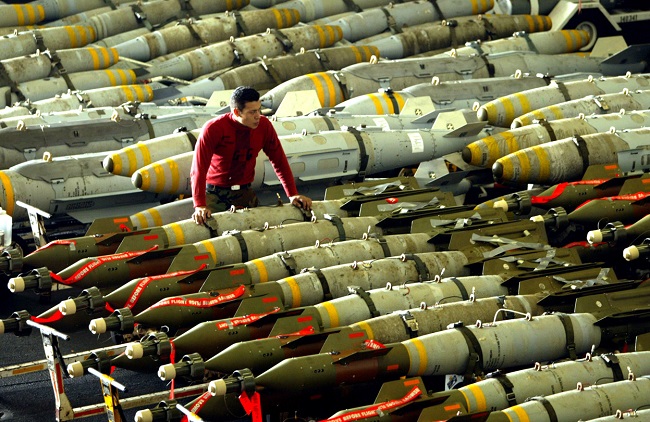
Air operations tempo
This chapter will describe the three distinct ready times used in Command: ‘Surge Operations’, ‘Sustained Operations’, and ‘Quick Turnaround’. The sources used to develop the sortie rate model includes everything from official sources to pilot handbooks to chit-chats with pilots to decade-old Usenet posts to multi-inch thick encyclopedias to NATO/WP doctrine & planning documents… a long list of sources by anyone’s standards.
Surge Operations Vs. Sustained Operations
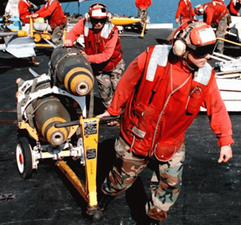 Although the relatively quick job of mounting stores on an aircraft would suggest a quite short downtime for most combat aircraft, real-life operations paints a different picture. For example, even the most heavily overtasked offensive airframes during Desert Storm in 1991, USAF’s F-4G “Wild Weasel” defense-suppression aircraft, had regular breaks between sorties of a minimum of 6-8 hrs. Most tactical aircraft during that conflict achieved 2.0 – 2.1 sorties per day during the hectic first days of the air war and/or during the ground offensive. Similarly modest sortie rates were exhibited both during the Vietnam conflict and the various operations in the 90s, particularly during Allied Force and Desert Fox, and sortie rates rarely exceeded 1.0.
Although the relatively quick job of mounting stores on an aircraft would suggest a quite short downtime for most combat aircraft, real-life operations paints a different picture. For example, even the most heavily overtasked offensive airframes during Desert Storm in 1991, USAF’s F-4G “Wild Weasel” defense-suppression aircraft, had regular breaks between sorties of a minimum of 6-8 hrs. Most tactical aircraft during that conflict achieved 2.0 – 2.1 sorties per day during the hectic first days of the air war and/or during the ground offensive. Similarly modest sortie rates were exhibited both during the Vietnam conflict and the various operations in the 90s, particularly during Allied Force and Desert Fox, and sortie rates rarely exceeded 1.0.
Two levels of operational activity exist for air operations – sustained and surge. Combat operations are often initated at surge rate in order to take advantage of battlefield opportunities, which means the units maintain a heightened tempo for a limited period of time. Typically 3-5 days. The tempo then slows to a sustainable level where maintenance, manpower and logistics can keep up. It is the commander’s job to find the appropriate mix of surge and sustained operations that maintains momentum without exhausing assets before the objectives have been met. For example, the 1991 Gulf War had two surge periods, one at the opening of hostilities and one during the short ground war.
Modern tactical strike aircraft typically fly a maximum of 2.0 – 2.1 strike sorties per day during surge operations, and 0.7 – 1.1 per day during sustained operations in normal conditions – standard number of pilots, realistic distances to target, normal maintenance needs, etc. This holds true for both carrier-based as well as for land-based tactical aircraft, although carrier-based aircraft tend to produce slightly fewer sorties than land-based aircraft. Escort and Combat Air Patrol (CAP) might do as many as 4 sorties per day. Actual wartime operations have shown that desperate attempts to produce higher sortie rates significantly raised the risk of aircraft and/or pilot error, and thus mission failure. In other words, producing higher sortie rates actually reduces the effctiveness of air assets and may increases losses. Interestingly enough, in Korea a CVA produced 90-100 sorties during surge ops. That is almost exactly 2.0 sorties per aircraft per day, which is the same number produced during the opening phases of the 1991 Gulf War.
 In order to cover the two operational tempos, Command can be configured to either use Surge Ops or Sustained Ops. In addition, some aircraft / loadout combinations have a Quick Turnaround option with very short ready times. Operational tempo and Quick Turnaround are doctrine settings, which allows the scenario designer to hard-code these and prevent the player from changing them during gameplay. Alternatively, the settings can be made editable and so that the player can set the tempo per side, per mission, per naval group / air base, or per unit. Click on the screenshot to the right for a full view.
In order to cover the two operational tempos, Command can be configured to either use Surge Ops or Sustained Ops. In addition, some aircraft / loadout combinations have a Quick Turnaround option with very short ready times. Operational tempo and Quick Turnaround are doctrine settings, which allows the scenario designer to hard-code these and prevent the player from changing them during gameplay. Alternatively, the settings can be made editable and so that the player can set the tempo per side, per mission, per naval group / air base, or per unit. Click on the screenshot to the right for a full view.
Strategic bombers like the B-52G/H and B-1B (as well as the later Block 20/30 versions of the B-2A) can fly a maximum of one mission per day, while in-theatre bombers like the Tu-16 or Tu-22M Backfire can surge at 1.0 to 1.5. Sustained rates of one combat sortie every 2-3 days is more typical.
Several airframes of exceptional complexity and/or unreliability have their uptime suffer significantly. For example the F-111D with its super-sensitive avionics package was not typically able to generate more than 1.5 sorties/day. Early (Block 10) models of the B-2A could only manage one sortie per 48h due to the need to re-process their delicate radar-absorbent coatings after each flight. Northrop at one point admitted in hearings that B-2As might only be able to sortie 2-3 times a week.
A lack of relevant targets affects the number of strike sorties flown. For instance, Harriers and Sea Harriers dropped no more than 200 bombs during the Falklands War, which translates to roughly 4.5 bombs per day on average.
 Many air forces are known to not being capable of maintaining high sortie-rates. This is a result of various factors: lack of pilot training, poor ground-crew proficiency, lack of miscellaneous base equipment in useful numbers, political or doctrinal harnesses, low pilot-to-airframe ratios, difficulties with complex hardware & sub-systems, etc. Sortie rates may be one sortie every three days during surge operations, and even lower during sustained operations. For example, during the wars in southern Africa around 1980 when the South African regime was under heavy pressure, the SAAF saw only sporadic action. Just one Iraqi ground attack mission and one anti-ship mission was recorded during the 1991 Gulf War in spite of the fact that they had several hundred strike aircraft. So even if strike aircraft exist in an Air Force’s inventory that doesn’t automatically mean they produce combat sorties.
Many air forces are known to not being capable of maintaining high sortie-rates. This is a result of various factors: lack of pilot training, poor ground-crew proficiency, lack of miscellaneous base equipment in useful numbers, political or doctrinal harnesses, low pilot-to-airframe ratios, difficulties with complex hardware & sub-systems, etc. Sortie rates may be one sortie every three days during surge operations, and even lower during sustained operations. For example, during the wars in southern Africa around 1980 when the South African regime was under heavy pressure, the SAAF saw only sporadic action. Just one Iraqi ground attack mission and one anti-ship mission was recorded during the 1991 Gulf War in spite of the fact that they had several hundred strike aircraft. So even if strike aircraft exist in an Air Force’s inventory that doesn’t automatically mean they produce combat sorties.
Some aircraft like F-117A, F-15E and A-10A are “12-hour aircraft”. All F-117A combat sorties and typically 90% of F-15E sorties are flown at night to take advantage of their sensor suites and to maximize survivability. The majority of A-10A sorties were flown at day, with occasional night sorties using IR-homing Maverick or flares to spot targets. Especially in the case of the F-117A this results in one sortie per 24h.
Scenario design: setting up a squadron for Surge Ops
Here is an example on how to produce realistic sortie rates in Command based on real-life data:
During surge operations a 12-aircraft F/A-18 squadron has demonstrated the ability to produce 24-26 sorties per day, i.e. an average of 2.0 to 2.1 sorties per aircraft per day. Lets use 24 sorties in this example. We also need to take into account that a day/night capable strike squadron should be able to produce at least three strike packages per day.
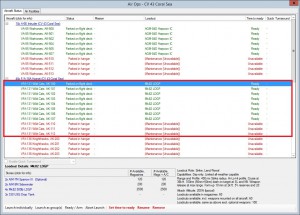 In Command, ready times for a high-end combat aircraft like the F/A-18 is six hours. Add in two hours of flying time, and each sortie takes 8 hours to complete. This means each aircraft can do three sorties per day (2 hrs flying, 6 hours prepping, three cycles per day) and you can therefore produce three packages consisting of eight of the squadron’s 12 aircraft. An overall total of 24 sorties.
In Command, ready times for a high-end combat aircraft like the F/A-18 is six hours. Add in two hours of flying time, and each sortie takes 8 hours to complete. This means each aircraft can do three sorties per day (2 hrs flying, 6 hours prepping, three cycles per day) and you can therefore produce three packages consisting of eight of the squadron’s 12 aircraft. An overall total of 24 sorties.
It would be unusual if not impossible for all aircraft in a squadron to be airborne at the same time. Aircraft take a lot of maintenance, even when an order to have maximum availability is in effect. Not everything is working all the time, you just need to deal with it. Typically, a minimum of 25-33% of the aircraft will be on the ground. This is a realistic number considering serviceability usually is in the high 70s during war. The difference between sorties (67% of the available aircraft) and serviceability (75% of available aircraft) stems from the fact that not all serviceable aircraft fly sorties. Some are used as ground/airborne spares, etc
In order to produce the most realistic sortie rates AND the correct number of flying aircraft, the scenario would therefore have 8 available aircraft and 4 unavailable ones. Click on the screenshots to the right for a full view.
 It is important to note that both types of downtime (‘unavailable’ and ‘ready time’) are complementary. A portion of your air inventory will be grounded at any given time, and the ready times serve to limit down to realistic levels the sortie rates of you ‘available’ aircraft. As such, both are equally important in terms of realistically modeling real life air operations. Sortie rates is a complex thing to model. It cannot be done through database settings alone; it also requires the scenario designer to correctly set up the number of available aircraft.
It is important to note that both types of downtime (‘unavailable’ and ‘ready time’) are complementary. A portion of your air inventory will be grounded at any given time, and the ready times serve to limit down to realistic levels the sortie rates of you ‘available’ aircraft. As such, both are equally important in terms of realistically modeling real life air operations. Sortie rates is a complex thing to model. It cannot be done through database settings alone; it also requires the scenario designer to correctly set up the number of available aircraft.
If 10 out of 12 aircraft are made available you would get 2.5 sorties per aircraft per day which means the scenario setup has probably moved beyond what’s realistic. There is an exception for this rule when it comes to simpler missions like CAS. This is covered in a separate chapter, below.
Scenario design: setting up a squadron for Sustained Ops
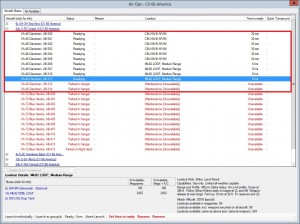 After a few days of surge operations the sortie rate drop sharply and stabilizes at around 0.7 to 1.1 sorties per aircraft per day. So lets use 0.85 in the following example. Ready time is 20 hours, and flying time is typically 2 hours with 2 hours to spare. Since the aircraft can fly one sortie per day, we need 10 out of the squadron’s 12 aircraft to produce a 0.85 sortie rate.
After a few days of surge operations the sortie rate drop sharply and stabilizes at around 0.7 to 1.1 sorties per aircraft per day. So lets use 0.85 in the following example. Ready time is 20 hours, and flying time is typically 2 hours with 2 hours to spare. Since the aircraft can fly one sortie per day, we need 10 out of the squadron’s 12 aircraft to produce a 0.85 sortie rate.
Click on the screenshot for a full view. Note that the ready times for the first six and last four aircraft have been skewed to avoid having too many aircraft in the air at once, as per real life experience.
It might be worth pointing out that deck aborts and deck/airborne spares are put on the ground and set to ‘unavailable’. Only the aircraft that actually carry out the strike will fly.
Alpha Strikes
According to several sources, a ‘standard’ Alpha Strike consists of 16-20 strike aircraft. A Nimitz-class carrier is said to have an upper limit of 150-160 sorties per day, which is about 2.0 sorties per aircraft per day on average for an 80-aircraft wing. Using surge rates, a carrier in Command can do 3 Alpha Strikes per day which is pretty high. The ready time for the strike aircraft is 6 hours, and the aircraft will spend about 2 hours in the air when hitting a target 350-400nm out. In Vietnam, carriers would often do only one or two Alpha Strikes per day. The same was true during the 1991 Gulf War.
During OEF in Afghanistan, Carrier Air Wings (CVWs) sustained 90 sorties a day as baseline, with each pilot flying 70 hours a month. In the Gulf in 2003 the CVWs produced just over 70 sorties per day.
It might be worth noting that the sortie rates achieved in war are quite different from the amazing 4.0 sorties per aircraft per day produced during a few exceptional exercises. In exercises the strike planners often cheat and take shortcuts that would be impossible during real operations. Flight deck cycles for continuous air ops like CAP impose restrictions on where aircraft can be spotted and how quickly ordnance and maintenance guys can start working. This complicates matters quite a bit and has dramatic effect on sortie rates. In a shooting war things slow down considerably and carrier-based aircraft seem to have awful trouble getting airborne. During the 1986 US attack on Libya (Operation El Dorado Canyon) the majority of the A-6E Intruders (7 and 8 out of 10 from each carrier) were initially planned to participate in the strike although only a total of 12 (60%) actually reached the target areas.
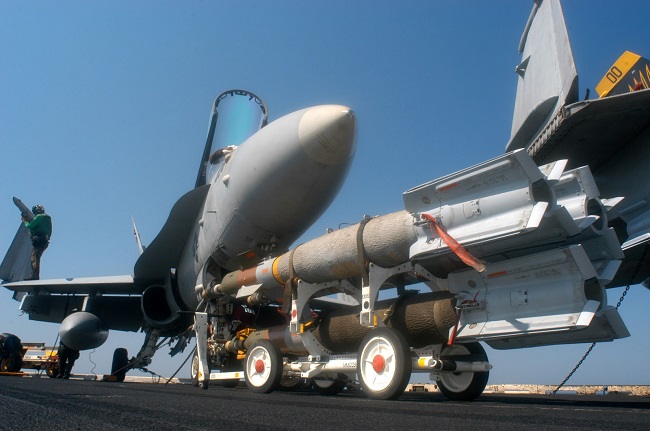
Quick Turnaround
If a simple short-duration mission is constantly repeated, aircraft turnaround can be very quick. CAS and local air defense are the types of missions that are often cited for the historically quick turnarounds. The pilots are already briefed and flight plans are simple and known. They basically fly the same route to attack a target within a set geographical area, without completely changing their missions, weapon types and attack profiles.
During the 1991 and 2003 Gulf Wars, A-10A Thunderbolt IIs and AV-8B Harrier IIs regularly flew 3 to 5 sorties per day in the opening phases of the ground offensive. The aircraft flew repetitive sorties from operating locations close to the objective (typically 50-60nm) in a target rich environment, no air threat, and greatly reduced SAM threat. In the most extreme case a total of 8 sorties (!) were flown by a single Harrier II during the 2003 seizure of Baghdad while operating from an expeditionary airfield named Three Rivers just South of Diyala River.
Since most of the tasking was typically performed in the air, in cooperation with forward air controllers (FACs), pre-flight briefings were short and simple. And the aircraft benefited from (typically) simple avionics, exceptional built-in maintainability, and ruggedness. Just refuel, rearm, and fly. With a 60nm distance to target and average speed of 400kt, plus 10 minutes spent in the target area, then each sortie would last 28 minutes. The exceptional eight-sortie example above means 224 minutes of flying time which translates to 3 hours and 44 minutes. This is less than the 4-5 hour sorties that other tactical jets regularly flew during these wars.
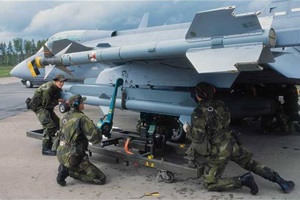 The Harrier air support requirements were written around the notion that the same aircraft could return to a target for a second attack 30 minutes after the first call for air support came in. In other words, the aircraft would be able to drop bombs, return to its forward base, refuel and rearm, and fly back and drop a second load on the same target in 30 minutes. There are not many aircraft out there that can do that. In the 1980s, pairs of USAF A-7 Corsair IIs could be turned around to fly a CAS sortie in less that 20min. This involved hot refueling and mounting 4x Mk20 Rockeye cluster bombs, but not reloading the M61A1 cannon.
The Harrier air support requirements were written around the notion that the same aircraft could return to a target for a second attack 30 minutes after the first call for air support came in. In other words, the aircraft would be able to drop bombs, return to its forward base, refuel and rearm, and fly back and drop a second load on the same target in 30 minutes. There are not many aircraft out there that can do that. In the 1980s, pairs of USAF A-7 Corsair IIs could be turned around to fly a CAS sortie in less that 20min. This involved hot refueling and mounting 4x Mk20 Rockeye cluster bombs, but not reloading the M61A1 cannon.
During the surge phase of the 1967 Six-Day War and 1973 Yom Kippur (October) War, Israeli aircraft flew up to 5 and 4 sorties per aircraft per day respectively. This was possible thanks to short distances to target, simple briefings and in-air tasking or re-tasking, extremely well-trained pilots and ground crew, and simple munitions (dumb bombs and rockets). The distance to enemy air bases in Egypt was typically 120-250nm, and 110nm-220nm in Syria. For CAS missions the distance was in many cases less than 30nm. Assuming the average distance to the air bases was 180nm, average speed 450kt, with 10 minutes over target, each sortie would last as little as 58 minutes. Three such sorties means 174 minutes of flying time which is 2 hours and 54 minutes. Please note that this is a simplified example and in reality each sortie lasted longer than this. For CAS, the airborne time would probably be shorter.
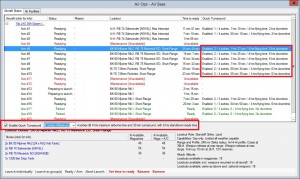 Swedish anti-invasion plans called for highly dispersed basing and short-range missions against air, surface and ground threats. Typically, a 16-aircraft squadron would disperse to as many as 4 different bases, civilian airfields, reserve airfields and highway strips, and protect the kingdom by staging series of small hit-and-run attacks in quick succession. The Swedish Air Force ground crews were well-trained professionals, and 1 technician and 5 conscripts could ready an aircraft in no-time. Turn-around times could be as low as 10-12 minutes for air-to-air and simpler anti-invasion weapon configurations.
Swedish anti-invasion plans called for highly dispersed basing and short-range missions against air, surface and ground threats. Typically, a 16-aircraft squadron would disperse to as many as 4 different bases, civilian airfields, reserve airfields and highway strips, and protect the kingdom by staging series of small hit-and-run attacks in quick succession. The Swedish Air Force ground crews were well-trained professionals, and 1 technician and 5 conscripts could ready an aircraft in no-time. Turn-around times could be as low as 10-12 minutes for air-to-air and simpler anti-invasion weapon configurations.
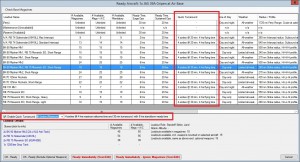 In Command, relevant loadouts have a ‘Quick Turnaround’ option that allows aircraft to fly a certain number of short duration sorties in quick succession with a maximum overall airborne time limitation. For example, 3 sorties with 4 hours total flying time and 20 minute turnaround between each. The aircraft will then step down for the period set by the loadout’s Surge Operations or Sustained Operations ready time. Click on the screenshot for a full view.
In Command, relevant loadouts have a ‘Quick Turnaround’ option that allows aircraft to fly a certain number of short duration sorties in quick succession with a maximum overall airborne time limitation. For example, 3 sorties with 4 hours total flying time and 20 minute turnaround between each. The aircraft will then step down for the period set by the loadout’s Surge Operations or Sustained Operations ready time. Click on the screenshot for a full view.
It should be noted that aircraft flying Quick Turnaround sorties may be re-armed with a different loadout without having to step down, granted the new loadout is quick-turnaround capable. This means you can fly the first two Quick Turnaround sorties with iron bombs, re-arm with rockets for the third sortie, and cluster bombs for the fourth.
Limiting Factors
There are three limiting factors for quick turnaround: flying time, the number of sorties (land-refuel-rearm-takeoff), and day/night capability. All three are used to determine if the aircraft can be quickly turned around to fly another sortie, or has to step down. Of these three, the airborne time limitation is probably most predominant.
It should be noted that the average duration for completed sorties is used to estimate how long the next sortie will likely last. When added up (total airborne time for completed sorties + estimate for next sortie), the simulator will order the aircraft to step down if the overall time exceeds the maximum allowed flying time. Because of this, Quick Turnaround is only possible for short-range missions such as CAS, anti-invasion surface strike, or short-range intercept. Maximum practical radius is typically limited to 200nm, with each sortie lasting no more than 60 minutes.
 As an example, assume a given Close Air Support (CAS) loadout allows a maximum of 3 Quick Turnaround sorties and 4 hours of total flying time. If the first sortie lasts more than two hours (say, 2.5 hrs), the aircraft will be ordered to step down after just one sortie flown because the next sortie is also estimated to last 2.5 hours. This would have brought the total airborne time to 5 hours which exceeds the four-hour limitation. If the aircraft lands after completing 2 sorties with 3 hours total airborne time, the aircraft will also be ordered to step down because the third and last sortie is estimated to last 1.5 hours. In this case the total airborne time would have become 4.5 hours. With these limitations in mind, if the player wants the aircraft to fly three sorties in a row, he must make sure that each takes less than one hour to fly. Once an aircraft steps down it will typically not be ready for at least six hours. Both the Quick Turnaround and stand down (Surge and Sustained Ops) ready times are listed in the Loadout Selection window.
As an example, assume a given Close Air Support (CAS) loadout allows a maximum of 3 Quick Turnaround sorties and 4 hours of total flying time. If the first sortie lasts more than two hours (say, 2.5 hrs), the aircraft will be ordered to step down after just one sortie flown because the next sortie is also estimated to last 2.5 hours. This would have brought the total airborne time to 5 hours which exceeds the four-hour limitation. If the aircraft lands after completing 2 sorties with 3 hours total airborne time, the aircraft will also be ordered to step down because the third and last sortie is estimated to last 1.5 hours. In this case the total airborne time would have become 4.5 hours. With these limitations in mind, if the player wants the aircraft to fly three sorties in a row, he must make sure that each takes less than one hour to fly. Once an aircraft steps down it will typically not be ready for at least six hours. Both the Quick Turnaround and stand down (Surge and Sustained Ops) ready times are listed in the Loadout Selection window.
Most aircraft can only do quick turnaround in daylight. There is a number of reasons for this, both technical and human. Each loadout in the simulator has a parameter that tells if the loadout is Quick Turnaround capable at night, and it might be worth noting that the Quick Turnaround day/night capability is different from the loadout’s actual day/night capabilities. If an aircraft returns to base just before sunset and there isn’t enough time to get it readied and airborne before darkness, the aircraft will automatically step down. As nighttime falls, the aircraft will only fly single sorties even though Quick Turnaround is enabled. As soon as the sun rises the aircraft will return to using Quick Turnaround.
Typical ready times and airborne times
Here follows some examples of typical ready times and max airborne times for Quick Turnaround-capable loadouts:
A-10A Thunderbolt II and AV-8A/B/C Harrier/Harrier II Close Air Support (CAS) loadouts: maximum 3 sorties and 4 hours airborne time, 15 minute turnaround for simple loadouts, 30 minute turnaround for more complex loadouts (e.g. 2 vs 6 Maverick missiles).
Swedish Viggen and Gripen anti-invasion air-to-ground (CAS/BAI) and anti-ship loadouts: 3 sorties and 4 hours airborne time, 12 minute turnaround for simple loadouts, 20 minutes for complex.
Israeli CAS loadouts: 3 sorties and 4 hours airborne time, 15 minute turnaround.
Israeli strike loadouts: 2 sorties and 4 hours airborne time, 30 minute turnaround.
Israeli strike loadouts, Six-Day War, Operation Moked (airbase interdiction on day one): 5 sorties and 8 hours airborne time, 60 minute turnaround, 10 hours stand-down time.
Israeli strike loadouts, Six-Day War, Close Air Support (CAS): 5 sorties and 10 hours airborne time, 30 minute turnaround, 10 hours stand-down time.
Most other BAI/CAS loadouts, land-based aircraft: 2 sorties and 4 hours airborne time, 30 minute turnaround.
BAI/CAS loadouts, carrier-based aircraft: 2 sorties and 4 hours airborne time, 90 minute turnaround due to carrier launch & recovery cycles.
Air-to-air loadouts, land-based aircraft: 2 sorties and 5 hours airborne time, 30 min turnaround.
Air-to-air loadouts, carrier-based aircraft: 2 sorties and 5 hours airborne time, 90 min turnaround due to carrier launch & recover cycles.
Doctrine Settings
In many scenarios it would not make sense to have a Quick Turnaround capability. Because of this the scenario author can set the desired Doctrine options in the scenario editor. The player will not be able to change the Doctrine settings unless the scenario author has explicitly given the player the ability to edit them. This is similar to the way nuclear weapons release is handled, which is normally not player-editable as well.
In the Doctrine window there are three selectable Quick Turnaround options: Disabled, Enabled, and ‘Fighters and ASW’. Disabled means that Quick Turnaround is not possible and the checkboxes in the Air Operations (F6) and Ready Aircraft (loadout selection) windows are disabled. When Enabled, all loadouts that support Quick Turnaround will have the the checkboxes enabled. The third option, which is also the default option, is ‘Fighters and ASW’. This means that Quick Turnaround will be available for air-to-air loadouts, anti-submarine loadouts, and a handful other loadout types such as cargo or troop loadouts, but not strike loadouts. In other words, Quick Turnaround is disabled for strike aircraft but the player is still allowed to land a helicopter, pick up troops or cargo, and head out in just a few minutes.
Manually configuring the number of sorties to fly
The maximum number of Quick Turnaround sorties that can be flown varies with each loadout, but is typically 2, 3 or 4. In some cases it would make sense to limit the number of short-range CAS sorties to less than the maximum, for instance when trying to mirror a real-life operation or forcing a stand-down due to changes in the tactical situation. For these reasons, the number of Quick Turnaround sorties to fly before standing down can be manually configured.
Backwards compatibility
The operational tempo Doctrine Setting is by default set to ‘Surge’ and Quick Turnaround is set to ‘Fighters and ASW’. This means that older scenarios will work exactly like they did before Quick Turnaround was introduced. It should also be noted that the default Doctrine configuration will prevent players from changing these settings during normal gameplay, similar to the way nuclear weapons release is not player selectable by default.
If a scenario author wants to change the Quick Turnaround settings or the operational tempo, he has to update the Doctrine settings in the scenario editor. The same applies if the scenario author wants to allow the player to change these settings during gameplay. Please note that there is nothing that prevents the player from change these settings himself through the scenario editor. It should be pointed out that changing these settings will most likely unbalance the scenario and affect realism.
Scenario design: Persian Gulf War (1991) – Close Air Support using A-10A Thunderbolt II
 An A-10A Thunderbolt II squadron with 18 aircraft generated up to 5 sorties per aircraft on average during the first day of the ground offensive in the 1991 Gulf War. They operated primarily in daytime, and since Iraq is close to the equator, there is roughly 15 hours of daylight. The following example shows how to set up this squadron in Command in order to produce the correct number of sorties.
An A-10A Thunderbolt II squadron with 18 aircraft generated up to 5 sorties per aircraft on average during the first day of the ground offensive in the 1991 Gulf War. They operated primarily in daytime, and since Iraq is close to the equator, there is roughly 15 hours of daylight. The following example shows how to set up this squadron in Command in order to produce the correct number of sorties.
Eighteen aircraft flying 5 sorties each would generate a total of 90 sorties in 24 hours. Using Surge Ops ready times and three Quick Turnaround sorties, one mission takes up to 5 hours to complete ( = 4 hours airborne time, 3 x 20 minute quick turnaround). The second mission will require the aircraft to stand down for 6 hours first, and the amount of time needed to complete two missions is 16 hrs ( = 2 x 4 hours airborne time, 2 x 3 x 20 minute quick turnaround, and 1 x 6 hours standdown time).
The ground crews can only perform quick turnaround in daylight. If we assume that the aircraft also operate by night, using IR Mavericks or flares to locate targets, only one sortie is flown per aircraft. Add 6 hours of downtime and roughly 2 hour of flying time, and a total of 24 hrs have passed. Within that timeframe, each available aircraft will generate 7 sorties. Since not all aircraft are airborne at once, 6 of the 18 aircraft (33%) are set to unavailable. The 12 available aircraft will be able to generate a total of 84 sorties which is pretty close to the number generated in real life.
On the second day of the war, sortie rates had dropped to 4 sorties per aircraft per day. In other words, the 18-aircraft squadron would generate 72 sorties. As in the above example, two mission takes 16 hours to fly, and two full cycles (we need to add 6 hr ready time at the end) takes a total of 22 hrs. Flying only in daylight, each aircraft will generate 6 sorties. And, as in the above example, we set 6 of the 18 aircraft to unavailable to produce an overall total of 72 sorties.
Scenario design: Six-Day War (1967) – Operation Moked (airbase interdiction) and CAS
Operation Moked was the codename for Israel’s massive airbase interdiction strike that destroyed the Egyptian, Syrian and Jordanian Air Forces on the ground in the opening hours of the Six-Day War. Because of the unique and never-seen-before-or-after nature of this operation, the aircraft involved have been given separate entries in the database in order to more accurately reproduce the historical outcome. The following example shows how to set up a Super Mystere squadron in Command to re-produce the observed sortie rates.
 Israeli day-only attack aircraft produced an average of 5 sorties per aircraft on the opening day of the war, flying from ca 7 am to 20 pm. Operation Moked was, as far as we know, the only time in the history of aerial warfare where all aircraft in a squadron were airborne more or less at the same time. For this reason we’ll make a one-time exception from the rule that at least 25-33% of the aircraft should be made permanently unavailable. Israel had 35 Super Mystere B.2 (Sambad) of which we belive 32 were operational, and all of these should be made available for operations in the scenario.
Israeli day-only attack aircraft produced an average of 5 sorties per aircraft on the opening day of the war, flying from ca 7 am to 20 pm. Operation Moked was, as far as we know, the only time in the history of aerial warfare where all aircraft in a squadron were airborne more or less at the same time. For this reason we’ll make a one-time exception from the rule that at least 25-33% of the aircraft should be made permanently unavailable. Israel had 35 Super Mystere B.2 (Sambad) of which we belive 32 were operational, and all of these should be made available for operations in the scenario.
In order to produce a historically accurate sortie generation rates, a separate set of specially configured ‘Six-Day War’ loadouts should be used. For the Super Mystere B.2 these are:
Operation Moked [Phase I-IV], 250kg GPB, Long-Range
Six-Day War, First-Day CAS, 100kg GPB
Six-Day War, First-Day CAS, TBA 68mm Rockets
It should be mentioned that Command simulates proper day / night conditions and is accurately keeping track of daylight hours. This includes correct handling of the midnight sun and polar nights north of the polar circle. On June 5th 1967, nighttime (pitch black) conditions lasted until 04:33 local time, followed by twilight conditions at dawn (limited visibility) until sunrise at 05:33 local time. Twilight conditions at dusk (limited visibility) started with sunset at 19:41 and night at 20:41. Please note that Israel used Daylight Saving Time (DST) or Summer Time, and the scenario must be configured to use DST in order to get correct local times relative to Zulu time, sunrise and sunset. Daylight Saving Time can be configured in the scenario editor via the Editor => Scenario Time + Duration dialog window.
The air bases were struck in four waves starting at 07:45, 10:00, 14:00, and 17:20. Waves three and four involved fewer and fewer aircraft as there weren’t anything left on the enemy air bases to attack, and Israeli aircraft were re-tasked to CAS. Strike sorties typically lasted one to two hours. Assuming 1.5 hours average flying time with 1 hours pause between each, five sorties would take 11.5 hours to complete ( = 5 x 1.5 hours airborne time, 4 x 1 hour turnaround). The flying day would then start at approximately 07:15 and would last until 18:45. If an aircraft flies long-range strikes there is a chance that the aircraft will not be able to fly more than 4 sorties since the aircraft will be forced to step down at sunset. And if flying short-range sorties the aircraft will step down when reaching 5 sorties.
Scenario design: Yom Kippur War (1973) – Day 1 CAS, Day 2 air superiority strikes and CAS
During the most intensive phases of the 1973 Yom Kippur war, Israeli A-4H Skyhawks generated an average of 4x sorties per aircraft per day. On the opening day, A-4s flew combat missions from the outbreak of hostilities at 14:00 to sunset at 17:21. Due to bad planning and confusion, several 4-ship Skyhawk flights took off without any flightplans except ‘go and get them’. Pre-war doctrine was not followed and the aircraft were forced to go up against a well-prepared enemy, on Close Air Support (CAS) without proper intelligence or pre-planned targets, and poor coordination with ground forces due to a lack of Forward Air Controllers (FACs). This led to disaster and no fewer than five aircraft were lost.
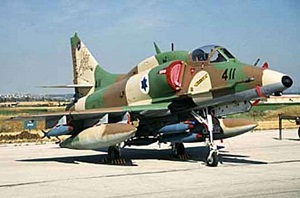 Israel had more than 160 A-4E, -4H and -4N Skyhawks in 1973. Of the seven A-4 squadrons, five saw action during the war and were reinforced with Skyhawks from the non-operational squadrons. Each of the five squadrons operated 24 aircraft apiece, with additional airframes held in operational reserve. Lacking radar and night-attack sensor suite, the aircraft operated mostly by day. However a handful skilled pilots performed low-altitude loft-bombing sorties at night, and two Skyhawks were involved in a night time attack on an Egyptian missile boat. Here, the Skyhawks operated in pairs carrying flares and bombs, taking turns illuminating the target and bombing.
Israel had more than 160 A-4E, -4H and -4N Skyhawks in 1973. Of the seven A-4 squadrons, five saw action during the war and were reinforced with Skyhawks from the non-operational squadrons. Each of the five squadrons operated 24 aircraft apiece, with additional airframes held in operational reserve. Lacking radar and night-attack sensor suite, the aircraft operated mostly by day. However a handful skilled pilots performed low-altitude loft-bombing sorties at night, and two Skyhawks were involved in a night time attack on an Egyptian missile boat. Here, the Skyhawks operated in pairs carrying flares and bombs, taking turns illuminating the target and bombing.
Skyhawks on Day 1 flew one or two sorties. Most aircraft took off between 14:00 and 15:00. Assuming a 1 hour sortie duration and 30 minute turnaround, one sortie takes 1 hr to complete, while two sorties take 2 hours and 30 minutes to complete ( = 2 x 1 hour flying time + 30 minute ready time). Three sorties would take 4 hours ( = 3 x 1 hour flying time + 2 x 30 minute ready time), and would be possible granted the aircraft took off at 14:00 and targets were close to the air base.
Not all aircraft would be airborne at once. If we assume that each aircraft flew an average of 1.5 sorties in real life on the first day of the war, a 24-aircraft squadron would generate 36 sorties. Since the player might be able to squeeze in 2.5 sorties per aircraft in the simulator, we therefore make 14 of 24 aircraft (60% = 1.5 / 2.5) available to produce 35 sorties. 10 aircraft are set to Unavailable.
On Day 2 of the war, the Israeli Air Force would seek to achieve air superiority over the Egyptian front by destroying Egyptian SAM sites west of the Suez Canal. The plan was to fly four successive attack waves using Skyhawks and Phantoms. The first would suppress AAA fire and seven Egyptian air bases, while the remaining three would attack SAM sites along the entire Suez Canal. In addition, the Skyhawk squadrons were needed to provide CAS over the Golan Heights and along the Suez Canal. As a consequence, Skyhawks operations were divided by CAS and air superiorty (anti-SAM and air interdiction). The two A-4E squadrons were assigned to CAS, while three A-4H/N squadrons were assigned to air superiority.
The 48 A-4Es flew no fewer than 56 CAS sorties between 05:38 and 10:00, but were then ordered to switch to air-superiority strike against Syrian mobile SAM sites. Time-on-Target (ToT) was set to 11:30 using nine AAA loft-bombing two-ship pairs and five SAM dive-toss bombing four-ship. Further strikes were carried out in the afternoon and evening. Ten Skyhawks were lost on day two, with a total of 15 destroyed so far. Many more had returned with battle damage.
A Skyhawk squadron with 24 aircraft would generate up to 4 sorties per aircraft per day during the most hectic periods of the war. The following example shows how to set up this squadron in Command in order to produce the correct number of sorties.
24 aircraft flying 4 sorties each would generate a total of 96 sorties in 24 hours. Using Surge Operations ready times and three Quick Turnaround sorties, one mission takes up to 5 hours to complete ( = 4 hours airborne time, 3 x 20 minute quick turnaround). The second mission will require the aircraft to first stand down for 6 hour, and the time needed to complete two missions is 16 hrs ( = 2 x 4 hours airborne time, 2 x 3 x 20 minute quick turnaround, and 1 x 6 hours standdown time).
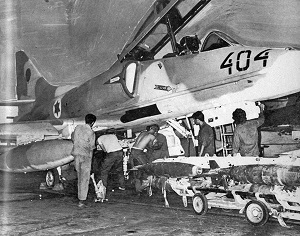 Since ground crews can only perform effective quick turnaround in daylight, and since night flying wear pilots out quickly, flying multiple sorties in quick succession at night is difficult if not impossible. If we assume that 1/3 of the aircraft performed a single night sortie using flares to locate targets, only 8 sorties were generated by the whole squadron. Add 6 hours of downtime and roughly 2 hour of flying time, and a total of 24 hrs have passed.
Since ground crews can only perform effective quick turnaround in daylight, and since night flying wear pilots out quickly, flying multiple sorties in quick succession at night is difficult if not impossible. If we assume that 1/3 of the aircraft performed a single night sortie using flares to locate targets, only 8 sorties were generated by the whole squadron. Add 6 hours of downtime and roughly 2 hour of flying time, and a total of 24 hrs have passed.
In those 24 hours each available aircraft will generate 6 1/3 sorties. Since not all aircraft are airborne at once, 8 of the 24 aircraft (33%) are set to Unavailable. The 16 available aircraft will be able to generate a total of 101 sorties which is very close to the number generated in real life. With this setup, combat losses will also have a direct effect on sortie rates similar to those observed during actual operations. For example, the loss of only four aircraft (16% of the total) will result in a sharp drop in sortie generation rates (25%).
Both, neither, either: Tempo & Turnaround
This chapter takes a look how the Air Operations Tempo and Quick Turnaround settings can be combined to produce the desired sortie generation rates.
Tempo: Surge Operations – Quick Turnaround: Fighters and ASW
This is the default setting in Command. Quick Turnaround is will be possible (and generally also used) for air-to-air loadouts, ASW loadouts, transport and tanker loadouts, civilian passenger loadouts, and all other non-strike loadouts that have support for Quick Turnaround. Please note that not all of the aforementioned loadout types allow Quick Turnaround. The Quick Turnaround time is typically 30 minutes for land-based aircraft and 90 minutes for carrier based aircraft due to carrier take-off/landing cycle limitations, with a 6 hr stand-down time.
Tempo: Surge Operations – Quick Turnaround: Enabled
This setup is described in the Scenario design: Persian Gulf War (1991) – Close Air Support using A-10A Thunderbolt II example given above. It might be worth noting that this configuration produces the highest possible sortie generation rates in Command. A such, these settings should be used with caution so that scenarios don’t become unbalanced by unrealistically high aircraft availability.
Tempo: Sustained Operations – Quick Turnaround: Enabled
This example is almost identical to the one above. The aircraft can produce the same number of sorties in quick succession, but when the aircraft eventually stands down it stays on the ground much longer. Typically 20 hours (one day), as specified by each loadout’s Sustained Operations ready time.
Tempo: Sustained Operations – Quick Turnaround: Disabled
These are the settings that produce the lowest sortie generation rates in Command. Quick Turnaround has been disabled for all loadouts, and aircraft fly maximum one sortie per day. Bombers see action every two to three days. This is the configuration that should be used for low-intensity air operations.
Sortie Rate Factors
So, what factors affect the preparation time (and thus sortie rate) for aircraft missions?
- Aircraft maintenance: aircraft must undergo the normal service procedures after each flight and after a given number of flying hours. Combat missions are quite tiring and after a period of hard hitting tempo, maintenance becomes a big factor. A few hours of maintenance per aircraft will not be enough and more extensive maintenance needs to be performed. Many services have emphasis on reducing flight accidents to a minimum which means that corners will rarely be cut even in wartime.
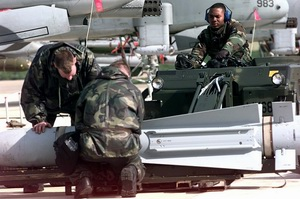 Rearming and de-arming: The amount of time needed to mount stores on an aircraft depends on the size and number of stores and any special equipment needed. Manually loading Mk82 500lb bombs using hernia bar is much faster than loading larger stores such as Mk84 2000lb bombs with hoists. Advanced munitions such as laser-guided bombs (LGBs) requires the munition to be electrically mated with the aircraft, and missiles Maverick, SLAM and HARM require special initialization procedures. Larger bomb loads require additional time. Worse, on aircraft carriers, loading of squadron aircraft must be done in sequence since each strike fighter squadron has only one bomb crew on the flight deck.
Rearming and de-arming: The amount of time needed to mount stores on an aircraft depends on the size and number of stores and any special equipment needed. Manually loading Mk82 500lb bombs using hernia bar is much faster than loading larger stores such as Mk84 2000lb bombs with hoists. Advanced munitions such as laser-guided bombs (LGBs) requires the munition to be electrically mated with the aircraft, and missiles Maverick, SLAM and HARM require special initialization procedures. Larger bomb loads require additional time. Worse, on aircraft carriers, loading of squadron aircraft must be done in sequence since each strike fighter squadron has only one bomb crew on the flight deck.- Refueling: A typical refueling system can pump 1000lb of fuel per minute. Refueling can not be done while aircraft are powered up, or in conjunction with special servicing.
- Pilot and aircrew rest: This is a major factor in air operations. Crew must receive a minimum amount of rest between missions in order to perform effectively. High-intensity combat operations are stressful and the effects of adrenaline on a pilot’s body will cause further exhaustion. The time necessary to return pilots to full combat readiness will therefore increase as a operation progresses. Furthermore, flying night sorties are far more demanding than flying in daylight and will have an effect on the number of sorties a pilot can produce. After three to five days of intense operations, fatigue will begin to crack both pilots and aircrew, and sortie rates will typically drop by at least fifty percent.
- Pilot-to-aircraft ratio: Aircraft are often hot-shared between multiple pilots. Pilot-to-aircraft ratio on board an aircraft carrier is typically 1.4 for fighters and strike aircraft. The number varies over a deployment as crews are moved to and from land. Support aircraft such as airborne early warning, jammers, ASW and tankers average 1.5 to 2.0 pilots per aircraft.
- Pilot skills: Not all pilots may have qualified for a certain weapon type or mission type, and may therefore be unable to participate. The Argentine Air Force during the Falklands War is just one of many great examples on this. Fewer sorties will be flown as a consequence.
- Planning & Briefing: A mission consumes much more of a pilot’s time than just what is spent in the air. Preparing for the mission will often be a long and elaborate process, particularly for offensive strike operations where large packages are assembled. Offensive air operations are either meticulously planned or almost invariably fail. A normal interdiction strike mission will usually take 6-8 hours to plan, brief and pre-flight, and 1 – 1.5 hours to debrief. What this essentially means is that you can generate quite a lot of defensive (air-to-air) sorties during a day, but very few offensive ones. Particularly when forming larger packages.
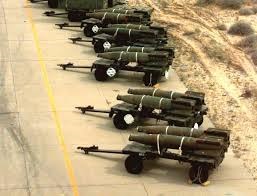 Munitions collection, assembly and transport: Aircraft ordnance such as missiles, bombs and rockets are stored in bunkers and warehouses. The ordnance is stored separately, typically split into weapon bodies, warheads, fuzes, engines, etc. Each component must be collected at their respective locations (some ammo dumps can be several square kilometers in size), assembled, tested, and transported to the parked aircraft. This takes time, typically many hours and in some cases (for large formations of B-52 bombers) several days.
Munitions collection, assembly and transport: Aircraft ordnance such as missiles, bombs and rockets are stored in bunkers and warehouses. The ordnance is stored separately, typically split into weapon bodies, warheads, fuzes, engines, etc. Each component must be collected at their respective locations (some ammo dumps can be several square kilometers in size), assembled, tested, and transported to the parked aircraft. This takes time, typically many hours and in some cases (for large formations of B-52 bombers) several days.- Miscellaneous procedures: Get aircraft in and out of protective shelters or revetments or below-deck hangars (typically under tow), start-up (either with an internal APU or an external power cable), align the inertial navigation system, enter mission data into the aircraft avionics suite (which may take as long as 30 minutes), check the electrical systems, and assemble on the flight line. Each of these actions normally does not take long on its own, but the adding-up can make a lot of difference. Normally, pilots man their aircraft 45 minutes before flight.
- Mission length: Obviously, long flight times reduce the time available for planning and execution of follow-on missions. Pilots should not work more than 15 hours per day, and the extra flying time eats into this amount. Longer missions often means more time spent over enemy territory which may result in a disproportionate increase in pilot fatigue. This reduces sortie rates as it takes more time to return a crew to full combat readiness. Lastly, the increase in flight time also leads to an increase in maintenance on those systems sensitive to sortie duration.
- Murphy’s Law: This universal law naturally applies to a combat environment as well. Anything that can go wrong in battle generally does so sooner or later.
To those that refuse to understand
Here is a little rant aimed at those who still refuse to accept real life sortie rates. If this is not you, please scroll down to the next chapter.
If you’re new to air operations, the low mission generation rates of combat aircraft may seem odd. But life aboard a carrier at sea or at a military airfield is different than the experience you are familiar with. Think beyond your Micky D’s fastfood existence. All tasks, particularly those involving the moving and prepping of ordinance, takes lots of time and effort beyond just bolting a bomb to a wing. This is easy to understand when you stand on the carrier deck but not so easy to grasp when the ‘ready time’ is just a number on the computer screen. Keep in mind that this figure is the net effect of the gazillion different reasons why sortie rates are as low as they are in real life. For example, the last-minute loadout changes from Washington (i.e., with several hours’ notice) was a significant part of what doomed the US Navy strike on Lebanon in December 1983. Only one A-6E Intruder left USS John F. Kennedy with the programmed loadout, and at least one aircraft had no bombs at all.
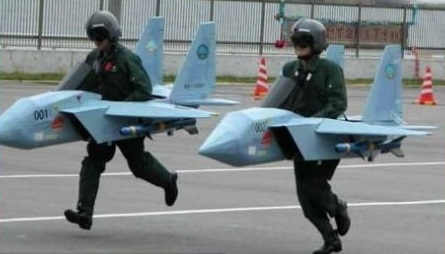 Besides refueling and reaming an aircraft there are lots of other elaborate and time-consuming activities that are required for flight ops. Briefings, mandatory maintenance, crew rest, etc. In fact, it can be difficult to have both helicopters aboard a ship flying at the same time because of regulations requiring that the pad remains open in case the first one develops an emergency and needs to RTB. In Command the player doesn’t have to deal with this and just wants all aircraft the air.
Besides refueling and reaming an aircraft there are lots of other elaborate and time-consuming activities that are required for flight ops. Briefings, mandatory maintenance, crew rest, etc. In fact, it can be difficult to have both helicopters aboard a ship flying at the same time because of regulations requiring that the pad remains open in case the first one develops an emergency and needs to RTB. In Command the player doesn’t have to deal with this and just wants all aircraft the air.
Flying a combat mission is much like running a marathon. It certainly isn’t for everyone. A marathon takes a lot of planning and preparation including several years of training, equipment purchases and testing, a strict diet plan, etc. Worse, good men have died running marathons. With this in mind one can easily understand why there is a limit to the number of sorties flown, and why pilots spend up to 8 hours of a 15-hour work day to plan, brief and debrief each combat mission.
How many marathon can a person run per day? One? Maybe two per day for a short period of time? Strangely enough, that’s the maximum number of sorties a combat aircraft can generate too. During the 1991 Gulf War the CAS-tasked A-10A Thunderbolt and AV-8B Harrier II pilots managed to clock up to 5 sorties per day. In one extreme case as many as 8. But these were short, repetitive missions that lasted less than an hour, and are comparable to half-marathons or 10-km. Which, in sum, roughly equals a couple marathons.
A six-hour ready time is not long when looking at what has to be done to re-mission that aircraft. The aircraft may have to be moved. The current weapons have to be removed safely and stowed. The new loadout has to be brought from the magazine after it is assembled and checked. The weapons have to be mated with fins etc before mounting. The ordnance has to be mounted and checked again. The aircraft computer has to be set up for the new loadout and checked. The pilots have to be given new briefings on the target and enemy defenses, the flight plans, supporting elements, emergency procedures, radio call signs and frequencies. The pilots then have to preflight their aircraft, and they must be inserted into the existing orderly chaos of flight operations. Finally, throw Murphy into the mix, and shake.
Stuff takes longer than you think.
An Ongoing Endeavor
The refinement of the aircraft ready times is a continuous effort. Some of the current figures may well turn out to be wrong, or too generic (or from another POV, not specific enough for aircraft-X with loadout-Y for mission-Z). Here’s where the Command community’s strong tradition of cooperation can once more be of benefit: If you think you have some piece of information that is not featured in the platforms database, or contradicts what is already in the dataset, your best bet is to contact the WarfareSims crew either in the forums or alternatively, directly at the WarfareSims.com site. Such communication is, in fact, already happening: aircraft ready times have, for many years now, been one of the hottest subjects of discussion in the various computer Harpoon and Command discussion forums. The Command crew members working on them are permanent dwellers on such hangouts and are in constant communication and exchange of information with fellow players, in the quest for perpetually refining the ready-time figures (in addition to all the other Command-related projects).
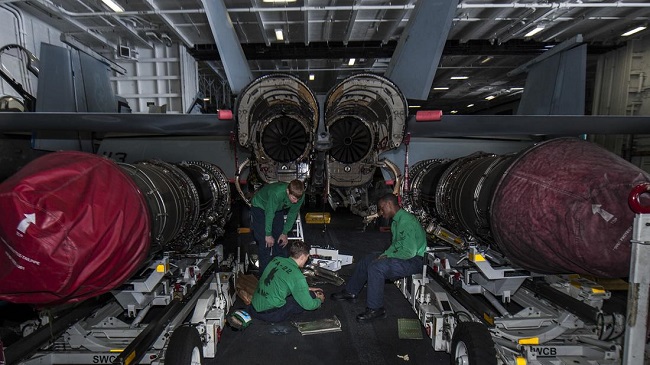
Stories
USS Enterprise vs USS Ranger, 1982
By TRADEVMAN, VS-37 “Sawbucks” flying S-3A Vikings off the USS Enterprise, March 1982 – September 1983
The CVBGs of the mid-1980’s military build-up were designed for continuous engagement with Soviet forces for a period of 72 hours. After that point, the battle group would have to disengage to replenish fuel for both the aircraft and the screening vessels. Ammunition replenishment was a different matter. Helicopter replenishment (VERTREP) of ammunition was expected during periods of engagement, but the transfer of fuel was determined to compromise the group integrity, and would not be undertaken until battlegroup had disengaged to safer waters.
In the summer of 1982, the USS Enterprise and the USS Ranger tangled with each other in a 72 hour off-going/on-going engagement to see if the Navy’s capability in the buildup to the “600 ship Navy” had reached to the planned expectation of a continuous engagement capacity. This was the first workup for the Enterprise after her extended overhaul that had started in 1979, and had her back at sea in the spring of 1982.
The Enterprise battlegroup located and engaged the Ranger battlegroup at a little under 400nm. All strike plans of the day were laid out to put the maximum number of aircraft on target simultaneously, coming from multiple directions. The length of the ingress and egress routs were such that we would launch the first group of 15 strike aircraft and the six to eight fighters (normal launch). This first group’s ingress plots required an additional forty to fifty minutes of flying time. This extra flight time allowed for the remaining half of what we had below deck to be spotted and launched. The fighters launched with the second group were used to relieve the escorts attached with the first launch. The strike involved no less than 31 of the 38 attack/ECM aircraft we carried.
[Dev’s note: An ‘Alpha Strike’ is typically a deck-load of aircraft, and in this case the carrier launched two deckloads with 40-50 minute separation, in effect making it two Alpha Strikes.]
 Our strike squadrons were all loaded with Mk76 target bombs, and made actual runs on towed targets running astern of the Ranger’s screening ships. Once the strike was completed, the recovery of aircraft went in reverse order. These aircraft were struck below and rearmed/refueled while the first group to launch was recovered. The time from the launch of the first aircraft to recovery of the last was right at four hours. Upon recovery, all 31 aircraft were fitted with “warshot” AGM-84, AGM-62, and refueled. With both ships company and the squadron personnel, working on the rearming and refueling, our second “On Steriods” strike was ready to launch in 3 hours, forty-five minutes. The follow-up strike was simulated as the attack aircraft were armed with live ordinance. These two large strikes were followed up with three more of the conventional sized (normal) Alpha Strikes that afternoon and evening. Five strikes in total.
Our strike squadrons were all loaded with Mk76 target bombs, and made actual runs on towed targets running astern of the Ranger’s screening ships. Once the strike was completed, the recovery of aircraft went in reverse order. These aircraft were struck below and rearmed/refueled while the first group to launch was recovered. The time from the launch of the first aircraft to recovery of the last was right at four hours. Upon recovery, all 31 aircraft were fitted with “warshot” AGM-84, AGM-62, and refueled. With both ships company and the squadron personnel, working on the rearming and refueling, our second “On Steriods” strike was ready to launch in 3 hours, forty-five minutes. The follow-up strike was simulated as the attack aircraft were armed with live ordinance. These two large strikes were followed up with three more of the conventional sized (normal) Alpha Strikes that afternoon and evening. Five strikes in total.
The first two strikes that we made against USS Ranger on days one and two were of these “Strikes-on-Steroids” type. The remaining three strikes were the more typical 20 aircraft type strikes. The engagement with the Ranger was done with the standard complement of aircrews in all squadrons that made up CVW-11. Not extra crews, as would be expected in a conflict with the Soviets. “Strikes-on-Steroids” meant “If it could get off the deck with ordnace, that aircraft was in the strike plan.” In a shooting war with the Soviets, there would be no aircraft down because of preventative maintenance, or because of the lack of aircrews. We launched no less than five Alpha Strikes at the Ranger for the first two days from a range of 300NMI, and four on the third day. It took both ships company and the squadron personnel to get it done. We regularly launched four aircraft per minute (faster if Ivan was watching). Daytime recoveries were at thirty seconds intervals, with night recoveries taking a minute. This simulated engagement with the Ranger came at the cost of three of the Enterprise’s deck crew, and I understand, the Ranger lost one man during the same time period. (there’s your price for readiness)
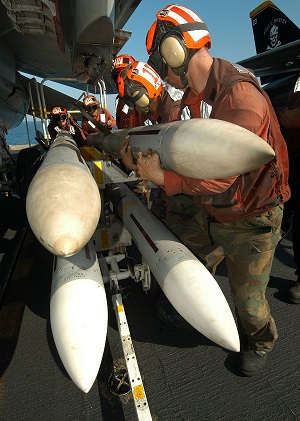 The engagement earned the Enterprise her “Battle E”, and was awarded the victory. It was an exciting time. We were a young crew that didn’t know any better on our first cruse. We had just come out of the yard, so all of our equipment was in excellent condition. Much of this I’m sure is how we managed to get so many aircraft over the target.
The engagement earned the Enterprise her “Battle E”, and was awarded the victory. It was an exciting time. We were a young crew that didn’t know any better on our first cruse. We had just come out of the yard, so all of our equipment was in excellent condition. Much of this I’m sure is how we managed to get so many aircraft over the target.
[Dev’s note: This engagement was part of a demonstration and it should be pointed out the Navy made several shortcuts to achieve these results. As such, this is not a good example of a carrier’s combat capabilities in wartime. A carrier would have difficulties launching “Strikes-on-Steroids” while at the same time carrying out other missions like fleet air defense, ASW, etc. In this exersise the strike aircraft flew a near-identical strike each time so there was no need to plan and brief/debrief each strike, there was no complex coordination of assets, no aircraft were lost to enemy air defenses, and in reality the threat was non-existent so stress was lower than in a shooting war. By comparison, during the 1986 strike on Libya (Operation El Dorado Canyon) the USN had difficulties getting 12 A-6E Intruders off the decks of two aircraft carriers. Similarly, during the 1991 Gulf War, aircraft carriers never managed to produce the number of sorties expected from them.]
Air Operations at RNAS Yeovilto
Day-flying typically takes place at 08:30 until 17:00, for 4.5 hrs of flying time on a normal day including night flying. The average sortie of a Seaking Mk.4 Commando is 2 hrs. Max endurance is 4hrs and depends on how fat the crew are weight wise. The average Seaking flies 2 hr sorties with a 15 min crew change and refuel, then another 2 hr. Therefore in one day the same aircraft can fly 4 day-sorties and 2 night-sorties, 6 a day total. If it flies a 4 hr sortie it will only do 2 day-sorties and 1 night-sortie, 3 a day total.
T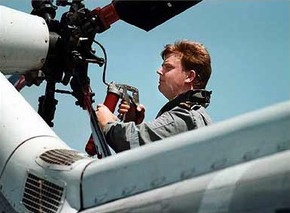 he Lynx is different as it depends on its weapon load. Endurance is the big factor on this sports car of the air, a max loadout of 4 Sea Skua missiles will reduce endurance by quite alot. Average Lynx sortie is 2 hrs with 2 Sea Skua missiles, Stingray torpedoes or Mk11 depth charges. The same rule applies for the Lynx about re-fuels and crew changes. It can land, refuel, rearm 4 Sea Skua and launch in less than 25 mins, with 2 Stingray or 2 depth charges less than 15 mins .
he Lynx is different as it depends on its weapon load. Endurance is the big factor on this sports car of the air, a max loadout of 4 Sea Skua missiles will reduce endurance by quite alot. Average Lynx sortie is 2 hrs with 2 Sea Skua missiles, Stingray torpedoes or Mk11 depth charges. The same rule applies for the Lynx about re-fuels and crew changes. It can land, refuel, rearm 4 Sea Skua and launch in less than 25 mins, with 2 Stingray or 2 depth charges less than 15 mins .
The Sea Harrier FA.2 can normally fly 4 1.5 hr sorties a day or 2 1.5 hr sorties at night. An FA.2 in Air Defense loadout of AMRAAMS and ASRAAMs can be refueled and off the deck in less than 1 hr. CVS sortie rates with a mixed airgroup of Sea Harrier FA.2, Harrier II Gr.7 and Seaking ASaC will normally do 16 sorties a day but can surge to 30-40 sorties a day for a limited period.
1967 Six-Day War: Israel vs Egypt, Syria and Jordan
The brilliant air campaign by the Israeli Air Force in 1967 is a (if not the) best-case example of high sortie generation rates. The mind-boggling intensity of this air operation has not been achieved before or after. A detailed account of the first day of operations can be found on the ACIG website.
Israel decided to launch pre-emptive strikes on all airfields in Egypt, Syria and Jordan when it became clear that an Arab attack was imminent. Operation Moked would require a considerable number of sorties, but Israel had trained hard to get the most out of its Air Force by slashing turnaround times and get aircraft refueled and rearmed in as little as 7-10 minutes. The Day One airfield attack plan called for 960 sorties to be flown by ca 70 fighters and 150 strike aircraft – an amazing 4.2 sorties per aircraft on average.
At the outbreak of hostilities, Israel was outnumbered more than 3 : 1 in combat aircraft. Sources give conflicting information on the exact number of aircraft available, but it was roughly like this:
Air defense / multirole fighters:
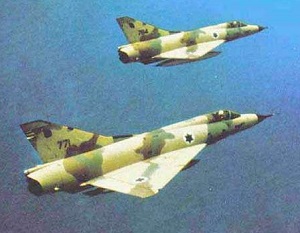 72x Mirage IIICJ/BJ/CJ(R) (62/3/2 operational, 3 sqn)
72x Mirage IIICJ/BJ/CJ(R) (62/3/2 operational, 3 sqn)
Strike aircraft:
51x Ouragon (40 operational, 2 sqn)
35x Mystere IVA (33 operational, 2 sqn)
35x Super Mystere B.2 (24 or 35 operational, 1 sqn [out of 42 a/c delivered, 12 lost in accident, plus 5 ‘borrowed’ l’Armee de l’Air airframes undergoing overhaul at IAI])
19x Vautour IIA/N/BR (18 operational, 1 in overhaul at IAI, 1 sqn, 25 pilots, 7 navigators)
15x Meteor F.Mk.8, FR.Mk.9, and T.Mk.7/8
76x Magister trainers (45 operational, 2 sqn)
Total available fighters and strike aircraft:
– 204 “in being”
– 197 “combat-ready”
– 183 “fully manned”
Phase I of the operation would hit 10 airfields in Egypt. Time-on-Target (ToT) for the first wave was 07:45 Israeli time (08:45 Egyptian time). The ten bases would be hit continuously at roughly 10 minute intervals with the last target hit at 09:00. Aircraft would attack in groups of four aircraft each. One additional airfield was hit due to navigational mistake and seeing several Egyptian combat aircraft on the ground. The strike aircraft carried runway-penetrating bombs, and the bombing run was followed by two to three strafing passes on parked aircraft and other targets. Ca 170 IDF/AF fighters were involved with 10 shot down. 196 Egyptian aircraft were claimed destroyed on the ground and 8 in the air, 140 of these were confirmed. All available aircraft had been used in the attack, with only about a dozen fighters used for air defense of Israel: four in the air and eight on ground alert.
Phase II used the same method as in the first phase and involved ca 100 aircraft (another source says 164 sorties flown) with one shot down. It hit 10 airfields in Egypt with ToT 10:00 to 12:30. 107 Egyptian aircraft claimed destroyed on the ground and 8-9 in air combat, the number of confirmed is not known.
Phase III was directed at Syria (82 sorties), Jordan (ca 51 sorties), Iraq (4 sorties using Vautour strike aircraft) and Egypt (4 sorties), 141 sorties total. It began at 12:48 with the majority of strikes carried out 14:00-16:00. Ca 130 aircraft participated with 4 losses. 61 Syrian, 30 Jordanian and 12 Iraqi aircraft claimed destroyed on the ground and 12 in air combat, the number of confirmed is not known.
Phase IV targeted 5 airfields in Egypt and Syria. ToT 17:20 to 19:00. Fewer than 60 aircraft took part for 2 lost. 12 Syrian aircraft claimed destroyed on the ground.
By the afternoon on June 5th 1967, 24 air bases had been hit, most of them repeatedly. 16 radar sites had also been struck. Ca 530 air interdiction strike sorties had been generated, of these ca 150 sorties were flown by Mirage IIIs. With the Arab Air Forces out of action, the IDF/AF changed focus to Close Air Support (CAS), with 268 sorties flown on the first day of the war. This brings the total number of strike sorties to 798. Subtracting the Mirage III sorties since these aircraft also flew, the number of sorties produced by 123 operational Ouragans, Mysteres, Super Mysteres (Sambads) and Vautour, plus a few Magisters, was approximately 650. which is a staggering 5 sorties per aircraft per day on average.
After the Arab air bases had been destroyed sortie rates plummeled as the Israelis had rather bad Close Air Support (CAS) coordination. So the extreme sortie generation rates was pretty much a one-day event. For example, the Mystère was used as a ground attack aircraft during the war. Seven were lost flying while producing 610 sorties, an average of ca 3.5 per day.
The 105th Squadron was the largest fighting squadron in the Israeli Air Force with a total of 35 Super Mystere B.2s, known locally as Sambads. Out of the original 42 aircraft bought from France, 12 had been lost in accidents by 1967 leaving 30 airframes. However, I’Armee de I’Air sent 15 Super-Mysteres to IAI for overhauls or major repairs, and five of these were airworthy and were adopted by the Israeli Air Force for the duration of the war. Of the 35 airframes, it seems 32 were available for operations. The Super Mystère B.2s flew 128 sorties on day one, producing an amazing average of 4.2 per aircraft. Four aircraft were lost, and nine total throughout the war for 507 sorties flown.
Israel lost 19 aircraft in over 1000 combat sorties on day one, an attrition rate of ca 5 percent per sortie and 23% of the overall force. Such losses are significant for sustained air operations. Ca 271 Arab aircraft were destroyed on the ground. By the time the war ended, Israel claimed to have destroyed 451 Arab aircraft, 1000 artillery pieces and 25 Arab air force bases. Israel lost 45 aircraft both in the air and on the ground.

A critical review of the Six-Day War by The Journal of Strategic Studies can be found here: Air Power in the Six-Day War. Here are some highlights:
After the destruction of much of the Syrian Air Force on 5 June, Israel mostly ignored Syria to concentrate on Jordan and Egypt. The IAF did fly some airstrikes against Syrian defenses on the Golan in preparation for an eventual ground assault (flying roughly 100 ground attack sorties against Syria on 6 and 7 June, and 225 sorties against Syria on 8 June). On 5 June, most of the IAF’s day was taken up in its counter-air operations against Egyptian, Syrian, Jordanian and Iraqi airbases. The IAF contributed a relatively small number of airstrikes against Arab ground forces on 5 June, flying only 268 ground-attack sorties on all three fronts (compared to 614 on 6 June and 652 on 7 June). Against Sinai, the Israelis flew only 170 ground-attack sorties on 5 June (compared to 286 on 6 June and 321 on 7 June) and probably destroyed no more than 12–15 Egyptian tanks. On 6 June, the IAF was committed more fully to ground support, but Israeli airstrikes on all three fronts started with the Arab forces and infrastructure farthest from the frontlines and then slowly worked their way back toward their own advancing ground forces. As a result, most of the IAF airstrikes flown against Arab ground forces were actually interdiction sorties directed against logistics and rear-area formations, rather than the frontline units and operational reserves whose defeat were the keys to Israeli victory. For example, the IAF only became a significant factor against the Egyptian combat forces on the Sinai front on 7 June, when Israeli aircraft hammered the masses of Egyptians surging back to the canal. The official IDF report on the war found that nearly all of the Egyptian armored vehicles destroyed by airstrikes were destroyed during the Egyptian retreat – not during the battles in eastern Sinai where the campaign was decided. Similarly, on 5 June, of the 95 air-to-ground sorties the Israelis conducted against the West Bank, 42 hit targets in the Jordan valley and only 32 struck targets in the key combat zones around Jerusalem and Janin.
Here is another recommended article written by James D. Perry on Arab-Israeli Wars: 60 Years of Conflict
Here is another recommended site covering Vautours operations. First Wave
1973 Yom Kippur War: Israel vs Egypt and Syria
The Israeli sortie rates in 1973 were a bit different than in 1967. The enemy was far more competent, and heavier losses had a pretty nasty effect on Israel’s ability to generate sorties. On average, Israeli aircraft produced 4.0 sorties per aircraft per day, while the Egyptians averaged 0.6 sorties per aircraft per day. Each side flew about 10 000 sorties. In October 1973, Israel had 127 F-4E Phantoms, 162 A-4E/H Skyhawks, 35 Mirage IIICs, 24 Super Mystères [18 serviceable, 6 lost during the war], and about 40 Neshers. A total of 887 Super Mystere Saar sorties were flown throughout the war, the majority of them in support of IDF ground forces, for two pilots killed and 6 aircraft lost.
Although Arab pilots were still not up to Israeli standards, they had gone through more realistic training programs than earlier. Egypt operated more than 400 modern jet aircraft, including 210 MiG-21 and 100 MiG-17 fighters and 80 Su-7B attack aircraft, and 30 Tu-16 bombers. In addition, 105 fighters from Algeria, Libya and Iraq operated under Egyptian command. Another major addition to the Egyptian Order of Battle (OoB) were 175 SA-2, SA-3 and SA-6 batteries, and a number of radar-directed ZSU-23-4 air-defense guns. The Syrian Air Force possessed 300 combat aircraft, including 200 MiG-21 and 80 MiG-17 fighters, and 30 Su-7B attack aircraft. Ground-based air defenses employed SA-2, SA-3, SA-6 and SA-7 missiles.
Egypt and Syria had built hardened shelters after the 1967 defeat, and few of their aircraft were destroyed on the ground. The Israelis lost as many as 8 aircraft in 52 major dogfights against the Egyptians, and Egypt lost 162. Egyptian air defenses destroyed 35–45 IAF aircraft but also shot down 45–60 of their own aircraft. Israel lost 6-10 aircraft in 65 major dogfights against the Syrians, and Syria lost 162. Syrian air defenses shot down 27 Israeli aircraft but shot down several dozen of their own. The Arabs probably lost more than 400 aircraft in total. Israel lost about 100, of which 87 were to ground fire.
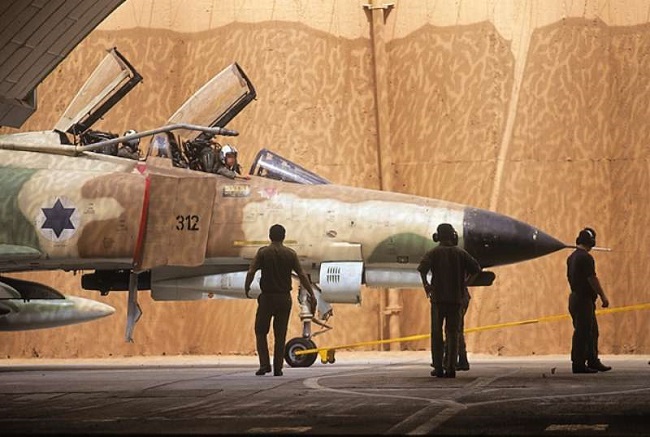
Recommended articles
Here are some highly recommended articles that gives further insight into the challenges of producing aircraft sortie rates.
The Carrier Myth (Requires Membership)
Published in 1999, this report takes a critical look at the 1991 Gulf War carrier operations and uncovers what really happened. Some highlights:
A report by the Center for Naval Analyses in Alexandria, Va., pointed out that carrier aircraft flew just 6,297 sorties over land to drop bombs, working out to only about 24 sorties per day per carrier. The experiences of USS Theodore Roosevelt, CVN-71, were representative. CVN-71 arrived on station near Qatar with 20 F/A-18 multirole fighters, 18 A-6 medium bombers, and 18 F-14 fleet defense interceptors. Over 43 days of the war, the F/A-18s averaged only 1.28 sorties per aircraft per day. Roosevelt “surged” during a brief ground war in late February 1991. The result: an average of 2.03 sorties per aircraft per day.
American Carrier Air Power at the Dawn of a New Century (Download)
Some highlights from this 2005 RAND report:
Page ‘Summary xi’ (13th page):
The average flight operations day aboard each carrier was 16 hours for the first 23 days, after which it ramped down to around 13-14 hours. Each air wing averaged 120-130 sorties a day.
Page 22 (48th page):
Throughout the war, carrier-based strike assets in all participating air wings averaged around 40 actual shooter sorties a day per carrier.
Page 23 (49th page):
Each carrier conducted flight operations for roughly 14–16 hours a day, with overlaps as needed to keep an average of three two-aircraft sections of fighters constantly over Afghanistan for on-call strikes against emerging targets […] Most aircraft flew triple or quadruple deck-cycle missions, with a typical cycle duration being an hour and a half (or 1+30). [A 1+30 cycle is one that lasts an hour and thirty minutes from an aircraft’s launch to its recovery.] Of all missions flown, 25 percent lasted longer than five and a half hours, with some F/A-18 missions lasting up to ten hours.
Page 26 (53rd page):
The operating tempo was fairly moderate, with one bow catapult and the two waist catapults typically in use. Because a deck cycle involved the launch of an outgoing strike package and the recovery of the previous launch, sortie duration had to be in multiples of 1+30 deck cycles as mission needs demanded.
Page 26 (53rd page):
Throughout Enduring Freedom, the aircrew work schedule entailed 14 days on duty followed by a day off for rest, with the normal peacetime workload being five days on and one day off. Although many Navy combat missions were of an unprecedentedly long duration, the daily combat sortie rate was not especially onerous. Each air wing flew an average of 30–40 combat sorties a day, with the maximum being around 42, since that rate was more than enough to support the CFACC’s target-coverage requirements. The remaining sorties that made up the daily baseline of 90 per air wing entailed tanker, electronic warfare, command and control, and other mission support.
Page 30 (56th page):
The carrier air wings committed to Operation Enduring Freedom sustained a substantial, if far from record-breaking, sortie rate throughout the campaign. Each flew a baseline of 90 sorties a day, and each met the CFACC’s tasking every day. Their commanders uniformly felt that this sortie rate was maintainable for an extended length of time. To cite but one case in point, VFA-97, flying the oldest F/A-18s in the Navy’s operational inventory, had pilots averaging 72 flight hours a month, as compared to 30 a month during a normal peacetime deployment. The air-wing squadrons typically sustained utilization rates of more than two and a half times their normal programmed flying hours.
[Dev’s note: This translates to a daily sortie rate of 0.6 to 0.8 for the air wing’s Tomcats and Hornets.]
Page 51 (77th page):
With respect to maintainability, the F/A-18E experienced the fewest maintenance man-hours per flight hour of the entire air wing in Abraham Lincoln throughout Iraqi Freedom’s three-week period of major combat. At the start of the war, the squadron was averaging around 15 maintenance man-hours per flight hour, as compared to 20 for CVW-14’s F/A-18Cs and 60 for its F-14s.
Sortie Generation Capacity of Embarked Airwings (Download)
This is a very informative paper written in 1998. It covers the variables that has the most effect on air operations such as airframe capacity, pilot and aircrew capacity, and flight deck capacity. Some highlights:
Page 1 (7th page):
The creation of sea-based air power is a complex process, involving hundreds of people and sophisticated machines. Aircraft are launched, recovered, dearmed, spotted, repaired, exchanged with hangar deck aircraft, serviced, fueled, configured with ordnance, and armed all within the few minutes of a deck cycle. In this paper, we focused on the three major requirements of this process:
– Aircraft must be mission capable (MC).
– Aircrew must be available to fly the aircraft.
– Flight deck crews must ready aircraft for flight, launch aircraft, and recover the aircraft after completion of their missions.
Page 5 (11th page):
On average, 6 hours are required to prepare (plan, brief, and pre-flight the aircraft) each strike mission, and post-mission debriefs take about 1.5 hours. Eight of the 10 F-14Ds and 30 of the 36 F/A-18s on board are MC [Mission Capable] for strike warfare at the beginning of the operation.
Page 6 (12th page):
Pilot availability constraint: Pre-mission and post-mission activities require on average 7.5 (= 6 + 1.5) hours to complete. Enter this combined preparation and debrief time (7.5 hours) on the vertical axis of figure 3. Interpolating between the curves for cycle times of 1+15 and 1+45 gives a maximum pilot utilization rate of 1.4. This is smaller than the cap (3.0) the operational commander placed on pilot utilization rate. The maximum number of sorties each F-14 pilot can be expected to complete is 1.1 (= 1.4 x 0.80) and for F/A-18 pilots is 1.3 (= 1.4 x 0.95)
Page 7 (13th page):
Airframe constraint: Dividing the number of MC [Mission Capable] F-14s and F/A-18s by the number needed to meet the CNO goals […] gives 1.14 (= 8 / 7) for the F-14s and 1.11 (= 30 / 27) for the F/A-18s. Multiplying by the corresponding values […] gives 29 (= 1.14 x 25) F-14 sorties and 130 (= 1.11 x 39 x 3) F/A-18 sorties.
Page 41 (45th page):
The sortie rate for a type of aircraft9 has historically been used as the measure of warfighting capability. Typically, a single number is provided for each aircraft type which is intended to capture expected
performance in all possible real-world situations. Operationally, the sortie rate will be less than the number of flight opportunities. […] Execution of the mission of the carrier battle group may call for an air plan that limits the sortie rate of the aircraft, independent of the aircraft itself. We know from fleet data an F/A-18C squadron can average more than 4 sorties per day per aircraft with some aircraft flying as many as 7 sorties a day-a capability that cannot be realized under a 1+45 air plan. An accurate measure of airframe capacity must encom pass the variety of operational situations a carrier battle group may encounter.
Page 68 (71th page):
OPNAV Instruction 3710.7Q […] states that “daily flight time should not normally exceed three flights or 6.5 total hours flight time for flight personnel of single-piloted aircraft,” but adds the caveat that this restriction can be waived by the operational commander. If not waived, the OPNAV instruction requires sharp declines in pilot sortie rates when the missions are extended from single-cycle to double-cycle operations. Double-cycled flights are more demanding; certainly, more time is spent flying, much of which may be over enemy territory and may require more extensive planning.
Page 70 (73rd page):
A mission consumes much more of a pilot’s time than just what is spent in the air. Time is spent before the scheduled sortie preparing for the mission and following the sortie in debriefing. For instance, […] recommends pilots man their aircraft 45 minutes before their scheduled launch. This allows sufficient time for aircrew to conduct a pre-flight check of the aircraft and, after the engines are started, to align the inertial navigation system of the aircraft with that of the carrier, enter mission data in the aircraft computer, and check the aircraft’s electrical systems.
Page 71 (74th page):
Longer flight times not only reduce the time available for planning and debriefing a mission, but may increase the time needed to return a crew to full combat readiness. In many operational situations, longer missions spend more time over enemy territory and result in a disproportionate increase in pilot fatigue. If this is the case, the time available for planning and debriefing a mission is reduced further.
Page 74 (77th page):
Life on board a carrier during high-intensity combat operations is not an environment conducive to rest. The living habitat is noisy and, when coupled with the anticipation of combat, makes rest difficult to obtain. Moreover, after a combat mission the effects of adrenaline on a pilot’s body cause further exhaustion. The time necessary to rejuvenate aircrew to full combat readiness after each mission may increase as the operation progresses. This may mandate a reduction in the pilot utilization rate with time.
Page 86 (89th page):
– Each strike/fighter squadron has only one bomb crew on the flight deck to load ordnance on their aircraft. Loading of squadron aircraft must be done in sequence.
– Loading weapons other than Mk 82 GP and Mk 83 GP bombs requires a weapons hoist.
– Loading the F-14 with ordnance is more difficult and time- consuming than for the F/A-18.
– Special servicing cannot be done in conjunction with fueling and ordnance loading. In addition, electrical connections cannot be made during fueling.
Airbase Vulnerability to Conventional Cruise-Missile and Ballistic-Missile Attacks (Download)
T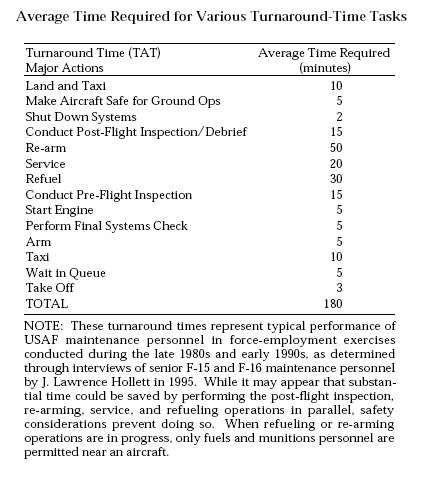 his article takes a look at sortie generation rates for air bases under attack, and introduces the RAND sortie generation model [Sortie Rate = 24 hours / Flight Time +Turnaround Time + Maintenance Time]. The model suggests a maximum average of only 2 strikes per day, for an “average fighter aircraft” based on data from F-15 and F-16 aircraft. When looking at sortie rates based on strike sorties, 6 hours is not that unusual. Written in 1999.
his article takes a look at sortie generation rates for air bases under attack, and introduces the RAND sortie generation model [Sortie Rate = 24 hours / Flight Time +Turnaround Time + Maintenance Time]. The model suggests a maximum average of only 2 strikes per day, for an “average fighter aircraft” based on data from F-15 and F-16 aircraft. When looking at sortie rates based on strike sorties, 6 hours is not that unusual. Written in 1999.
The Art of Unreasonable Expectations (Link)
Written by Galrahn in 2007, this article takes a look at the ‘360 sorties per day’ claim made by the Royal Navy for its new CVF carriers.
Observing Early Performance Metrics of the MV-22 (Link)
Another article on sortie generation rates by Galrahn, written in 2008.
Operation Desert Storm – Evaluation of the Air Campaign (Download)
This GAO report looks at the 1991 Gulf War air operation and is a must-read.
Operations Prairie Fire and El Dorado Canyon, 1986 (Link)
This is another must-read that looks at the 1986 attack on Libya in detail.
Lessons learned, Operation Odyssey Dawn (Link)
This article looks briefly at the US air strikes against Libya in 2011:
With a mere two days notice, Ellsworth Airmen were tasked to prepare several aircraft and build hundreds of precision munitions to provide the specific combat configuration needed for the mission.
CVW Strike Sortie/Aimpoint Improvement, unclassified point paper (DoN (N8QDR)) (No link)
Carrier forces today are much more apt today compared to the past.
1989:
– 36 Strike aircraft per wing (A-7, A-6)
– 162 sorties per day, max surge
– One target per sortie
– Assuming a 200-nm range to target (no refueling) and good weather, a CAW could strike 162 aimpoints in a single day2004:
– 44 Strike aircraft per wing (F/A-18C)
– 207 sorties per day, max surge
– Three to four targets per sortie
– Assuming a 200-nm range to target (no refueling) and good weather, a CAW can strike 693 aimpoints in a single day
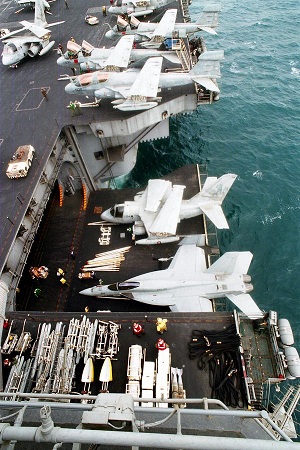 [Dev’s note: A 200 nm strike range is not realistic against a competitive enemy. Assuming the carrier stays at least 100nm offshore, you’re not striking all that far. Normally, a Carrier Battle Group (CVBG) normally likes to have a nice 250nm cushion around it, and a better estimate would be in the 300-400nm range. Increased distance will change the sortie rate because mission time and crew rest requirements, etc, will go up.
[Dev’s note: A 200 nm strike range is not realistic against a competitive enemy. Assuming the carrier stays at least 100nm offshore, you’re not striking all that far. Normally, a Carrier Battle Group (CVBG) normally likes to have a nice 250nm cushion around it, and a better estimate would be in the 300-400nm range. Increased distance will change the sortie rate because mission time and crew rest requirements, etc, will go up.
162 strike sorties spread among 36 strike aircraft means 4.5 sorties per aircraft per day. Such sortie generation rates have not been achieved during exercises where the USN cheated, relying on nonstandard conditions that would pose a major challenge in time of war. The max practical real-life surge operations sortie rate is around 2.0 – 2.1. This number is backed up by most other sources that states a Nimitz-class aircraft carrier can produce an overall total of 160 sorties with ca 80 aircraft — of which a small portion is strike sorties.
The number of targets per sortie sounds dubious as well. It can be assured that many of these “calculations” are based on the assumption that GPS guided air-to-ground weaponry will enable one-bomb-per-target. It also seems likely the air wing would operate against a country with little or nothing in the way of air defenses, and the numbers are extremely optimistic in scenarios against a competitive enemy, for example one capable of jamming or attacking GPS and communications satellites.]
Operation SERVAL – French Intervention in Mali (Download)
Studying this document on the French 2013 intervention in Mali in detail reveals some interesting details:
11 January, 2012: 4x Mirage 2000D armed with 2x LGBs each, night strike, 5 hours
13 January, 2012: 4x Rafale armed with 6x LGBs or 6x AASM each, night strike, 10 hours
14-19 January, 2012: Several strikes using 6x Mirage 2000D armed with 2x LGBs each
14-19 January, 2012: Several strikes using 4x Rafale armed with 6x LGBs or AASM each
A total of 14 aircraft were deployed – 8x Mirage 2000 and 6x Rafales
8 days of engagement from Jan 11 to Jan 19 (no sorties on the 12th)
60 strike sorties
No mission involved all strike aircraft. At least 25-33% of the aircraft stood on the ground, in some cases 50%.
Sortie generation rate is 60 sorties divided by 8 flying days divided by 14 aircraft = 0.53 sorties per aircraft per day. The document points out that this was an accelerated sortie rate. It also stresses that there was urgency in getting the militant columns stopped. That is why there was a ‘surge’. At the same time it should be noted that this operation was very asymmetrical, the distances were great, and relevant targets were in short supply. So the operation was not a good representative of what the French Air Force (or any other Air Force in the same situation) can achieve under more conventional wartime conditions.
V/STOL in the United States Marine Corps: The Past, Present, and Future (Download)
Page 3 (10th page):
They initially went to war [in the Falklands] with only 20 Harriers, but eventually were able to build their strength to 35. These were a mixture of 28 Sea Harriers, used primarily in the air-to-air role, and eight Royal Air Force (RAF) GR.3s, used for ground attack.
Page 5 (11th page):
During the course of the conflict, the AV-8 [Sea Harrier] squadrons received an additional 15 aircraft to augment their numbers and replace losses.
Page 6 (12th page):
The other key factor to the success of the Harrier in the Falklands was its reliability, which allowed it to maintain a high sortie generation rate. From April to June 1982 the British Harriers flew 2,197 sorties and 2,514 flight hours while maintaining an availability rate of 96%.9 The aircraft often flew three sorties per day and had an average cancellation rate of only 1% throughout the conflict.10
[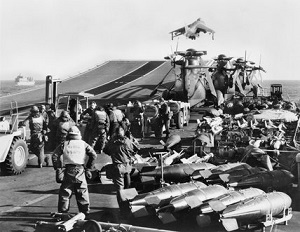 Dev’s note: the statement ‘The aircraft often flew three sorties’ does not mean an average of three sorties. Assuming there was an average of 25 aircraft available and 35 flying days (out of 45 days total, due to bad weather) the Harriers produced an average of 2.5 sorties per aircraft per day. It may be worth noting that the average flight time was as low as 1 hour and 10 minutes, which suggest many of these were short-range CAS or air intercept sorties. Another source says 1.2 sorties per aircraft per day on average, and a peak of 4 sorties.]
Dev’s note: the statement ‘The aircraft often flew three sorties’ does not mean an average of three sorties. Assuming there was an average of 25 aircraft available and 35 flying days (out of 45 days total, due to bad weather) the Harriers produced an average of 2.5 sorties per aircraft per day. It may be worth noting that the average flight time was as low as 1 hour and 10 minutes, which suggest many of these were short-range CAS or air intercept sorties. Another source says 1.2 sorties per aircraft per day on average, and a peak of 4 sorties.]
Page 8 (14th page):
The Harriers were able to achieve a higher sortie generation rate than conventional carrier-based (CV) aircraft because they were not tied to the limitations of catapults and arresting gear. For
example, towards the end of the ground war VMA-331 flew 56 sorties with 19 aircraft on one day alone.
[Dev’s note: This resulted in 2.95 sorties per aircraft per day when flying short-range CAS during the land offensive surge operation.]
Page 8 (14th page):
The 66 land-based Harriers operated from King Abdul Aziz Naval Base, located at Jubail, Saudi Arabia, about 100 miles from Kuwait. A smaller FOB was established even closer, 35 miles from the Kuwaiti border, at Tanajib. The FOB at King Abdul Aziz allowed the Harriers to reach the Kuwaiti border in 15 minutes and remain on station for roughly 28 minutes. The Tanajib FOB cut the transit time to the border to a mere five minutes and increased the time on station to 45 minutes if needed.15 The benefit of the STOVL Harrier was that it was closer to the front lines than any other fixed-wing aircraft, and it did not rely on the overworked tankers to provide fuel for the transit to and from the fight. Additionally, 50% of all Harrier sorties originating from King Abdul Aziz were sent to Tanajib to rearm and refuel. This capability was a tremendous force multiplier because it allowed quicker turn-around times, which resulted in higher sortie generation rates and more ordnance on target.
Page 9 (15th page):
Although the AV-8B was and still is a challenging aircraft to maintain, the squadrons reported readiness rates over 95% throughout the war. As seen in the Falklands, this phenomenal reliability coupled with the inherent flexibility of the STOVL aircraft were key to its success. The 86 aircraft deployed to the Gulf flew 3,380 sorties from 17 January to 28 February 1991.
[Dev’s note: The average sortie rate was 0.94 sorties per aircraft per day.]
A Comparison Of Sortie Rates For Land Based And Carrier Based Aircraft In Recent Conflicts (Link)
The Grand Logistics web site gives some sortie rates from various air forces during various conflicts. Note that the sources give the total number sorties flown, and do not distinguish between surge and sustained operation. The average numbers are just that, and includes days where fewer and more sorties were flown. The sources say nothing about maximum sortie generation rates or the minimum sorties generated on a day. Yet they give a benchmark for what can be sustained over a period of time.
During the 30 day invasion of Iraq in 2003 (Operation Telic/Iraqi Freedom), 113 land based aircraft of the Royal Air Force flew 2,481 sorties. A rate of 0.73 sorties per aircraft per day. (Source)
During the same conflict the American aircraft carrier USS Kitty Hawk,with 70 aircraft aboard, flew 3,000 sorties in 28 days. A rate of 1.53 sorties per aircraft per day. (Source)
During the 78 day bombing campaign against Serbia in 1999 (Operation Allied Force/Noble Anvil),41 land based aircraft of the Royal Air Force flew 1,516 sorties. A rate of 0.47 sorties per aircraft per day. (Source)
During the same conflict the American aircraft carrier USS Theodore Roosevelt, with 71 aircraft aboard, flew 4,270 sorties in 55 days (she then sailed to The Gulf and flew another 2,600 sorties over Iraq). A rate of 1.09 sorties per aircraft per day. (Source)
During the six week long liberation of Kuwait in 1991 (Operation Granby/Desert Storm), 158 land based aircraft of the Royal Air Force flew 6,000 sorties. A rate of 0.9 sorties per aircraft per day during the 43 day air war. (Source)
During the same conflict the American aircraft carriers in the Gulf were USS Midway, USS Ranger and USS Theodore Roosevelt: (Source)
– USS Midway, with 56 aircraft aboard, flew 3,019 sorties. A rate of 1.25 sorties per aircraft per day over 43 days or 1.59 sorties per aircraft per day over her 34 operational days.
– USS Ranger, with 62 aircraft aboard, flew 3,329 sorties. A rate of 1.25 sorties per aircraft per day over 43 days or 1.59 sorties per aircraft per day over her 38 operational days.
– USS Theodore Roosevelt, with 78 aircraft aboard, flew 4,149 sorties. A rate of 1.24 sorties per aircraft per day over 43 days or 1.36 sorties per aircraft per day over her 39 operational days.During the 192 day MED 05 deployment of the American aircraft carrier USS Theodore Roosevelt, Carrier Air Wing Eight (CVW 8) flew 16,000 sorties. A rate of 1.1 sorties per aircraft per day sustained for over six months.(Source)
[Dev’s note: Air wings in Operation Enduring Freedom (OEF) flew in excess of 120 sorties per day on many days, and fewer than 20 on some days, depending on the requested sorties in the daily ATO in theater. The tempo was rather relaxed, with few surge days. Not one day did a carrier fail to send the required number of sorties, and many days the air wings had room to send more if requested.]
New carrier unlikely to meet aircraft goals (Link)
Interesting article from 2014 that includes info on hoped carrier sortie rates. Some highlights:
The USS Gerald R. Ford’s “sortie generation” rate — the ability to launch and recover aircraft — is based on “unrealistic assumptions,” and key launching systems “are currently suffering from development problems and have poor or unknown reliability”
The Navy has said the new carrier promises about a 25 percent increase in sortie generation over the current Nimitz class.
The Navy plans for Ford-class carriers to launch and recover 160 aircraft a day over a sustained period and 270 during a wartime surge; the Nimitz-class requirement is 120 a day and 192 during a surge.
[Dev’s note: there are no records of 192 combat sorties being generated by a Nimitz-class carrier. The maximum is around 160-165. It is interesting to see that even the original figure to beat has been raised to unrealistic levels.]

Air Campaign Against the Iraqi Army in the Kuwaiti Theater of Operations (Download)
This is a highly recommended RAND report on the 1991 Gulf War. Some highlights:
Page XII:
The scope and complexity inherent in planning a high-tempo air campaign involving over 2000 sorties per day dictated that planning be conducted two days or more before missions were flown. A battle management system was used, operating within the campaign framework described above, to focus attack flights as the tactical situation shifted.
Page 12:
The Master Attack Plan (MAP) in its original and amended versions shows each day’s air operations as they were conceived by the planners. However, not all attack flights/missions were contained in the MAP. Specifically, it omits many of the sorties flown by the A-lOs and Marine aircraft. The ATO is the formal tasking for the air campaign, but for flights that flew multiple sorties, only the first is shown in the body of the ATO. Mission Reports (MISREPs) provide an accurate accounting of the mission accomplishments of each flight but we do not have a complete inventory of MISREPs. Sortie recaps show the number of sorties flown for each aircraft type by day, but the recaps do not tell where the sorties went and what they did.
Page 14:
Approximately 250 fixed-wing aircraft sorties and 8 Tomahawk Land-Attack Missiles (TLAMs) were employed against strategic offensive targets in the KTO on the first day. The effort against the Iraqi ground forces on the first day began wim about 400 sorties. One-hundred and forty-four A-lOs and OA-10s flew multiple sorties against preplanned artillery targets and from ground alert. On the first day, 294 A-10 sorties were flown, making it the heaviest A-10 flying day of the war. Additionally, 20 AV-8B close air support sorties were flown in the U.S. Marines Central Command (MARCENT) sector. Twenty-four F-16s were targeted against the Republican Guards, and 16 F-16s attacked Iraqi ground force command posts. Eight B-52s attacked Republican Guard positions to open the campaign. To isolate the Iraqi forces in the KTO, 20 sorties consisting of F/A-18s, A-6s, and F-15Es attacked bridges along the LOCs to Kuwait on the first day.
Page 15
On the second day of the scripted campaign, 130 F-16,24 F-18, and 9 B-52 sorties were tasked to attack Republican Guard positions. Across the tactical echelon, 178 A-lOs, 36 AV-8Bs, and 3 AC-130 sorties were flown. On the last day of the three-day scripted war, the B-52 effort increased to 25 sorties against the Republican Guard positions. From Day 3 until the week before the ground war began, the number of B-52 sorties planned and flown against the Republican Guard divisions ranged between 25 and 35 sorties daily. On the third day, F-16Ls Low-Altitude Navigation and Targeting Infrared at Night (LANTIRN) and F 15Es began night operations against Iraqi forces, using their onboard sensors to acquire targets. Thirty-five percent of the sorties flown by coalition air forces in the war were flown at night. This is the first time massed airpower has been used on a continuous basis against an opposing field army at night.
Page 15:
Air operations against the Iraqi forces in Kuwait shifted from the scripted campaign on January 20. The number of sorties flown on this day in the KTO was the lowest of the entire war. The weather was bad, and the continuity of effort dropped in the transition of the planning process. The bulk of the flying effort in the KTO on Day 4 involved 30 A-10 sorties employed in joint operations with AC-130 gunships.
Page 17:
Before January 26, the AV-8B force principally sat on CAS alert, averaging 35 sorties per day (slightly over 0.5 sorties per day per aircraft). Until Day 10, the AV-8s seldom exceeded 50 sorties a day. […] After the AV-8Bs began appearing in the ATO, their sorties jumped to an average of 68 sorties per day for the next 10 days, and then they increased their effort to over 90 sorties flown per day. The AV-8B force was essentially held in reserve for the first three weeks of the war.
Page 21:
Finally, to increase the sortie rate of the F-16 force, CINCCENT began quick-turning sorties out of King Khalid Military City in early February. By staging sorties out of King Khalid, F-16s could fly three sorties a day carrying four 2000 lb bombs without requiring air refueling.
Page 25:
The Marine AV-8Bs, however, doubled their optempo beginning the day before G-Day and for the first three days of coalition ground force operations. The average number of sorties reported flown by the AV-8Bs from February 15 until the day before the ground war was 74. For the four days of ground action in the MARCENT sector, the AV-8Bs flew an average of 149 sorties per day.
Page 51:
The sortie rate for the AV-8B aircraft started low. The AV-8Bs averaged 0.9 sorties/day over the course of the war. Using staging bases adjacent to the battle area, the AV-8Bs reached a peak of 218 sorties on the second day of the ground war.
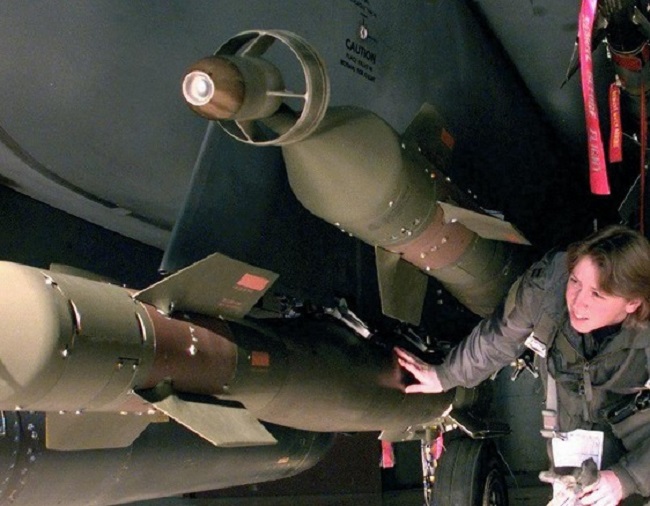
Frequently Asked Questions
What is a ‘sortie’?
In most circles, and also in Command, one sortie is take-off and landing. Flying three times in quick succession (quick turnaround) is considered three sorties.
However it should be noted that both the US Navy and US Air Force sometimes ‘inflate’ the sortie generation rates by defining each precision guided bomb (PGM) to be a sortie. This is a bit of a cheat because each bomb is not a unique sortie. However it may seem this was done to reflect the ability to hit multiple targets that precision weapons give aircraft. In Command, hitting multiple targets with PGMs are considered ‘multiple aimpoints’ not ‘multiple sorties’.
What does ‘sortie rate’ mean?
The sortie rate is the average number of sorties expected each day from each aircraft in a squadron.
What is an ‘Alpha Strike’?
Alpha strike is a term used by the United States Navy to denote a large air attack by an aircraft carrier air wing, first coined during the Vietnam War. It is the Navy’s version of the more widely used term “strike package”. More information can be found on Wikipedia (Alpha Strike).
I do not agree with the ready times in Command. What can I do about it?
The ready times in Command have been validated by men flying the real thing, some for more than 25 years. If you believe our model is incorrect, please provide us with reliable real-life information on air operations.
Photo credits:
US Air Force
US Navy
French Department of Defense
Swedish Air Force
MilitaryPhotos.net
Wikimapia
A Christmas gift: Community Scenario Pack #50 now available
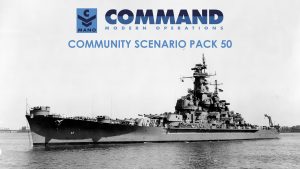 Following the release of the new Build 1527 update for Command, which includes the new v509 databases, Brandon Johnson has now also updated the famous Community Scenario Pack (CSP), the Command community’s curated anthology of user-created scenarios. The new update, out just in time for the Christmas celebrations, contains 15 new scenarios:
Following the release of the new Build 1527 update for Command, which includes the new v509 databases, Brandon Johnson has now also updated the famous Community Scenario Pack (CSP), the Command community’s curated anthology of user-created scenarios. The new update, out just in time for the Christmas celebrations, contains 15 new scenarios:
* Assault on Al Tanf, 2024: Located in Syria on the Iraqi border and within miles of the Jordanian border, the U.S. garrison at al-Tanf has, since 2016, served as a launching point for counter-ISIS operations and training for Syrian opposition factions fighting the jihadist group. Iranian and Iran-backed forces are deployed in close proximity to the al-Tanf desert outpost, which sits on the strategically significant Baghdad-Damascus highway. U.S. forces in al-Tanf established a 55-km de-confliction zone, beyond which lie an array of forces described as either “pro-regime” or “Iran-backed” that have set up checkpoints in the area. Several incidents in recent months underscore al-Tanf’s potential as a flashpoint between U.S. and Iranian and/or Iran-backed forces.
* Caravan, 1982: Since the start of the Iraqi invasion, the northern Persian Gulf has been the site of an intense naval war between the Iranian and Iraqi navies. Most of the fighting has been centered around Iraqi attempts to stop the flow of vital material to the port of Bandar-e Emam Khomeyni. The Iranian navy and air force have devoted significant forces to protect the convoys. Slightly over a year ago, the Iraqi navy first deployed a new weapon in their battle against the convoys, the French Exocet anti-ship missile. A few hours ago, Unit 114 of the Directorate of Technical Equipment detected another Iranian convoy departing from Bushehr.
* Dead from EABOve, 2027: Approximately 2 hours ago, following an earlier announcement by PRC of a blockade of Taiwan, US initiated hostilities with China after interdicting a PLAN SAG attempting to transit the Bashi Channel out to the West Pacific.The Chinese have taken the first blow, now they are ready to return the favor. US bases in the Philippines, Palau and Guam will be in their crosshairs.
You will be required to hold off the numerically superior PLA forces and do so while being subjected to heavy bombardment from PLARF elements.
For your forces to survive, they will be required to disperse, and to refuel and rearm at austere locations. Capturing PRC bases in the South China Sea for follow on operations is also a nice option.
This is a complex 2-day scenario, happening just after the author’s other scenarios “Tighten the Straitjacket” and before “Penetrating the Blockade”.
* Khrushchev’s War, Day 1 – France Enters the Fray, 1957: This scenario assumes World War III began in late April of 1957. During most of April in 1957, the Soviets sortied a large number of ships and submarines, claiming they were conducting a series of military exercises.
In the early morning hours of April 25, the Soviets initiated a large and well-coordinated attack on NATO forces.
NATO forces already at sea have been organized into task groups and ordered to hunt down Soviet ships and submarines. It is critical that NATO remain in control of the sea lanes. As commander of a French task group centered around the cruiser De Grasse, your mission will be to secure the waters south and southeast of Sardinia.
* Khrushchev’s War, Day 1 – Poseidon’s Play, 1957: You are in command of the Greek submarine Poseidon. She is actually an old American submarine, the Lapon, recently recommissioned and on loan to the Greek government. However, as her captain, you are sure Poseidon loves her new country as much as she loves the country where she was born.
Today, she will have a chance to prove that love. As the only Greek vessel in the southern waters of the Mediterranean, Poseidon has an opportunity to intercept a Soviet convoy on its way to the Egyptian city of Marsa Matruh. The Egyptians appear to have allied with the Soviets, although they have not yet officially declared war.
* Khrushchev’s War, Day 1 – The Battle of Elefsina, 1957: In the early morning hours of April 25, 1957, you receive a flash priority message. There is credible intelligence that a massive Soviet attack against NATO is about to begin.
As the commanding officer of the 114th Combat Wing of the Hellenic Air Force and its three squadrons of F-86E Sabres, your mission will be to help protect Greece from the Soviets and their allies.
* Khrushchev’s War, Day 2 – Head ‘Em off at the Sunda Strait, 1957: It is the second day of the war. Shocking news has arrived from Europe. The Soviet Union has launched massive attacks against European air bases and other military targets. There are reports that the American carrier Forrestal and the British carrier Bulwark have both been sunk.
You are in command of a British naval squadron in the Far East. Some elements of the Soviet navy have been operating in your area of responsibility. It will be your task to destroy these ships and submarines.
* Khrushchev’s War, Day 4 – Birmingham Goes Hunting, 1957: It is the fourth day of the war. Intelligence suggests the Soviets have sortied additional submarines and surface groups to threaten shipping in the Atlantic. You have been placed in charge of one of the task forces assigned to deal with this threat.
* Khrushchev’s War, Day 30 – South Dakota Says Goodbye, 1957: It is the end of the first month of the War of 1957. NATO has received reliable intelligence that a large surface group has left Soviet waters. It appears to be designed to attack NATO shipping trying to cross the Atlantic.
Most NATO ships are already engaged in other theaters of the war. No carriers and few submarines are available to intercept the battle group.
You are in command of a battle group of available vessels assembled to intercept and destroy the Soviet battle group. It is a curious collection of ships for the late 1950s, being centered on two World War II-era battleships, South Dakota and California. Both vessels had been reactivated shortly before hostilities erupted in Europe with the idea of using them as test platforms for new technologies. However, once the Soviet attacks started, these plans were put on hold.
* Korean Campaign (Operation Dragon Fire), 2018: It is the Spring of 2018, and it appears that Kim Jong-un is finally going to make good on his constant threats to launch an attack into South Korea.
* Operation Ardent Shield, 2030: The world’s worst fear just materialised. Open conflict has erupted between the world’s two superpowers over the South China Sea.
Singapore, as a neutral country but finding many of its fundamental interests in line with upholding the principles of UNCLOS and with keeping the US presence strong in the Pacific, has decided that it will allow US military assets to continue to refuel and resupply in the country, and for limited US military operations to be conducted from the country so long as no direct strikes on Chinese mainland territories are staged from Singapore.
* Operation Sallyport, 2029: In mid-2029, China commenced an intervention under the pretense of restoring order in Papua New Guinea. For Australia and its allies, the stakes were high, as the stability of the South Pacific, regional security, and the influence of Western alliances in the Indo-Pacific hung in the balance. The ensuing operation would determine the future of Papua New Guinea and reshape the power dynamics of the region.
* Ouadi Doum, 1986: In response to Libyan aggression in Chad, President Mitterrand has deployed French forces to Africa.
France is determined to prevent Libya from destabilizing its former colonies, and is concerned about the ability of al-Gaddafi’s government to stage long-range bomber attacks out of the Ouadi Doum airfield.
* Sapphire, 1977: On June 27, 1977, the former French colony of Afars and Issas gained its independence as the country of Djibouti. At first, the FLCS (Front for the Liberation of the Somali Coast), a guerrilla organization fighting against French colonial rule, celebrated this victory and was partially absorbed into the new country’s government.
But days after the declaration of independence, a splinter group formed calling for the integration of Djibouti into ‘Greater Somalia’. After gathering support, the group launched their insurgency against the Djibouti government and French forces stationed in the country.
Somali leader Siad Barre had primarily been focused on absorbing the Ogaden region controlled by Ethiopia, but started shifting his focus to the newly independent nation.
Somali forces that had been thought to have been preparing for an invasion of Ethiopia quickly deployed to the border with Djibouti. The French have started sending a large number of reinforcements to Djibouti, but due to the limited infrastructure and short time frame, this has been difficult.
The first units from metropolitan France arrived a short time ago, joining a number of units airlifted in from French territories in the Indian Ocean. French intelligence has assessed that there is a high likelihood that Somalia will launch an invasion in the coming days or hours, before most of the reinforcements can be brought in.
* Soviet Endgame – Seize Giebelstadt3, 1981: At the opening of the Third World War, the Soviet Union launched a continent-wide effort to sweep into NATO countries in a war of conquest.
This scenario focuses on one small aspect of the overall war. As a part of the effort to secure central Germany, the Soviet airborne forces, the VDV are tasked with taking the NATO airfield at Giebelstadt, just south of Würzburg.
The new community scenario pack is, as always, available for download at the Command Team site, and also on the Steam workshop.
The CSP now proudly counts 618 scenarios in its stable!
Santa’s coming to Defense town: Command PE v2.3 now available
 Boy, time sure flies past when you’re having fun. It’s been barely a little over half a year since the groundbreaking release of CPE 2.2, and here we are again with another milestone release for Command PE: Version 2.3 is now available for download by new and existing pro customers alike.
Boy, time sure flies past when you’re having fun. It’s been barely a little over half a year since the groundbreaking release of CPE 2.2, and here we are again with another milestone release for Command PE: Version 2.3 is now available for download by new and existing pro customers alike.
The v2.3 update follows closely on the steps of the commercial CMO v1.06 release, and leverages the numerous groundbreaking changes introduced in that update. Chief among them is undoubtedly the migration to a 64-bit architecture and the adoption of a brand-new, DirectX-11-based map engine.
Other new features include:
- Weather and the day/night cycle affect air sorties. Non-all-weather aircraft are grounded at night or in bad weather.
- C-RAM and counter-battery mechanics: Unguided rockets are no longer auto-detectable and unengageable: They can now be engaged by suitable weapons (Centurion C-RAM, Iron Dome etc.) but first they need to be picked up by sensors capable of detecting them. Sensors designed for counter-battery role can even backtrack the trajectory of a detected rocket or ballistic missile and provide a rough location of its firing point, thus enabling counter-battery fire.
- Target Priority Lists: Prioritize targets as part of doctrine settings. This makes it even easier to set up realistic targeting behaviors for the AI.
- Numerous UI tweaks and improvements such as revised zone management and mouse-driven selection on zones and patrol areas.
- Proximity-fuzed airburst round mechanics: Much more realistic modeling of proximity flak, a weapon/fuze type critical in WW2 and currently making a big comeback as a drone & PGM killer.
- New weapon type: Directional high-power microwave (HPM) projector weapons (aka “EMP guns”). Two distinct subtypes of EMP projectors are currently modelled: Mechanical antenna emitters like AFRL’s THOR/Mjolnir prototype, which emit a broad “broom sweep” EMP beam to effect single or multiple enemy units concurrently, and AESA antenna emitters like Epirus’ Leonidas system, which are able to form and direct multiple tight beams concurrently in order to defeat multiple threats.
- Per-sensor mast height. Different horizon ranges and LOS clearances for different sensors on the same platform.
- Terrain type-dependent skyline / land-cover heights. Some units can fly between treelines or buildings, or pop their mast-mounted sensors above the local vegetation to get a clearer look of the battlefield.
- Proper “QuickSink” mechanics: If you’ve seen any of AFRL’s videos on QuickSink then you know the tremendous potential of this new JDAM fuse, and the implications in any future maritime theater.
- Decoy mobile platforms: Can use entire full-kitted platforms as realistic-looking decoys.
- Rudder as a discrete component on ships & submarine, and rudder mechanics (incl. damage/destruction). If you’ve ever wondered by big ships and submarines feel very sluggish on turns, or are curious how the battleship Bismarck was significantly degraded after its rudder was stuck by a lucky torpedo hit, you can now find out.
- New OpenTopoMap layer: A superb layer for topography and road & urban networks that effectively replaces the now-retired Stamen map layers.
- Weapon-deployable platforms: For example, transport and launch child aircraft from parent aircraft (e.g. D-21 and WZ-8 recon drones).
- Numerous fixes and improvements on DIS connectivity – including a new start-up window for configuring the selected NIC as well as all other DIS-related properties.
- Numerous additions to Lua event hooks with new hook types such as UnitMovesBefore, UnitMovesAfter and OnStatusChange.
- The latest sim database releases with thousands of additions and tweaks.
In addition, v2.3 is the first CPE version eligible for submission into the ATO (Authority To Operate) process, with the goal of formally certifying its suitability for mass deployment into combatant commands, front-line units and other high-security environments.
CPE v2.3 is available for download to all customers through the Matrix Pro Sims personalized portal. Get it and turbocharge your wargaming, analysis and training capability today!
In the shadow of the Beast update: Community Scenario Pack #48 now available
 Following the groundbreaking release of the v1.06 update, bringing 64-bit finally to the mainstream version, it is now appropriate for a new release of the Community Scenario Pack (CSP).
Following the groundbreaking release of the v1.06 update, bringing 64-bit finally to the mainstream version, it is now appropriate for a new release of the Community Scenario Pack (CSP).
Brandon Johnson (Kushan) has updated the pack to version #48, with 12 brand-new scenario and 9 updates to existing works. Additionally, the default WRA firing ranges for AAW weapons have been set to “50% of max range”, and all scenarios have been rebuilt to the v501 releases of the DB3000 and CWDB databases.
Let’s take a look at new additions:
Action in the Bay of Vlore, 1969: After 1960, Albania broke ties with the Soviet Union and allied with China. In 1968, Albania again snubbed the Soviet Union by withdrawing from the Warsaw Pact in protest over the invasion of Czechoslovakia. The Soviet Union has decided to make a show of force by sailing ships into the Bay of Vlore and threatening to blockade ships attempting to enter or leave the Port of Vlore.
Dutch-Venezuelan Fishing Incident, 2025: Venezuelan fishing boats are violating Dutch fisheries. The Netherlands sends ships to address the issue. They have permission to fire on fishing boats that do not comply with their orders to stop and be boarded for inspection. Venezuela is unlikely to take kindly to this…
Jeannes Last Jaunt, 2009: It’s 2009 and a coup in Guinea has France trying to get their people out of an increasingly unstable situation. They’ve sent the aging helicopter cruiser Jeanne d’Arc and some supporting forces to get the job done. It shouldn’t be too difficult, right?
Kicking Down the Door, 2019: In August 2017, Donald Trump hinted at possible military action against Venezuela due to its crumbling democratic institutions. By December 2018, Russia’s Ambassador in Caracas claimed foreign powers were plotting to topple the Venezuelan government. The situation escalated in January 2019 when Juan Guaido, an opposition lawmaker, declared himself the “interim president” of Venezuela, contrary to the country’s constitution. While the U.S. and several nations supported Guaido, Maduro, the standing president, labeled this as a U.S. coup attempt. Countries like Russia, China, and Cuba stood by Maduro. Tensions further intensified when Venezuelan military forces loyal to Maduro blocked foreign aid on 23 February 2019. In response to this and Guaido’s appeal for international help, the U.S. took action on 24 February 2019.
Mediterranean Fury 7 – Under Pressure, 1994: You command the USS Nimitz CVBG, along with the newly arrived HMS Ark Royal. The two carriers have worked together in the Indian Ocean and will now move through the Med and into the Atlantic as a team. You have three major tasks: Neutralize the Black Sea Fleet; establish air superiority over Thrace and the Turkish Straits area, and significantly degrade the Bulgarian air force. USS Iowa and Kearsarge have a secondary task to complete. But you are under pressure to get it done quickly, with limited resources and with severe logistic constraints.
Operation Brass Drum – Second of Desert Storm, 1993: In the wake of a civil war that erupted in Tajikistan, Iran began supporting the Tajikistan opposition. However, their alleged involvement in a plane bombing that killed 176 people, half of whom were U.S. citizens, strained international relations. Despite Iran’s denial of involvement, a betrayed spy provided evidence against them. As a result, the Security Council displayed distrust towards Iran. In response, the Iranian President imposed a blockade on the Strait of Hormuz. Given the recent surge in terrorist activities and U.S. political involvement in the Persian Gulf, this act intensified tensions. The U.S. President responded by ensuring freedom of navigation through the strait and utilizing existing U.S. military presence in the region. Meanwhile, Iraq seemed to align with Iran’s stance, frequently violating restrictions set after the Gulf War. It appears the Middle East may be on the brink of another Desert Storm.
Operation Ghost Rider, 1985: A long-range strike from the UK on a simulated airfield 100 miles southwest of Goose Bay, Labrador by 10 F-111Es from the 20th Tactical Fighter Wing on October 18, 1985. This exercise was one of the proof-of-concept operations for Operation El Dorado Canyon, the April 1986 strike on Libya.
Operation Gray Advantage, 2023: The current Standing NATO Maritime Group 1 is sent to track a Russian task force making its way to the Denmark Strait. Right now, there are only three ships in the flotilla, so I’m assuming other assets get attached. Things are very tense as the scenario starts–it assumes the destruction of a US drone last month was followed by the shoot-down of a Russian Su-27 over Romania. Russia has sortied a task force and it is probably on its way to the Mediterranean. Russia also has something to prove with this mission. As you will see, things escalate…
Penetrating The Blockade, 2027: China has declared a de facto blockade of Taiwan. A week earlier, the 3rd MLR successfully interdicted some PLAN forces heading to waters off east Taiwan, however it is expected that a good number of PLAN navy sub surface assets leaked through, while other PLAN assets had already moved past the 1st Island Chain before the blockade was announced. The PLAN Shandong CSG is presumed to be somewhere in the Western Pacific. It is expected to be tasked with disrupting allied forces resupply efforts to Taiwan and Allied forces.
The 2023 North Korean Nuclear Attacks Part 1, 2023: Short scenario, all you really need to do is sit back and watch. You can probably play it in real time if you’re interested in observing a ballistic missile attack. (The story is based on The 2020 Commission Report on the North Korean Nuclear Attacks Against the United States by Dr. Jeffrey Lewis, but updated to reflect 2023 politics)
The Old vs the New – The Madagascar Crisis, 2025: Following Madagascar’s tumultuous 2023 elections, the nation intensified its ties with China, culminating in numerous treaties in 2024 that bolstered economic and political relations. Concurrently, Madagascar escalated its territorial dispute with France over Indian Ocean islands. However, the new government faced internal dissent, further exacerbated by its inadequate response to cyclones in 2024, leading to widespread protests and a violent crackdown. In 2025, an attempted coup instigated clashes between loyalist and opposition forces. Amid this chaos, France and China bolstered their military presence, with confrontations between the two powers in the Indian Ocean escalating. The conflict saw alleged war crimes and the killing of French NGO workers by Madagascar’s air force. Consequently, France has opted for airstrikes against the Malagasy loyalists, aiming to bolster the opposition and reassert its waning influence in former colonies.
Tighten the Straitjacket, 2027: Scenario is focused on the 3rd MLR located on the Philippines, facing the Straits of Luzon. The scenario assumes China just announcing a blockade on Taiwan, with a PLAN SAG heading to Taiwan’s east coast to carry out a blockade of Hualien port. Your mission is to degrade/destroy the SAG.
The new community scenario pack is, as always, available for download at the Command Team site, and also on the Steam workshop.
The CSP now proudly counts 587 scenarios in its stable!
The upgrade number of the Beast: Command v1.06 is here
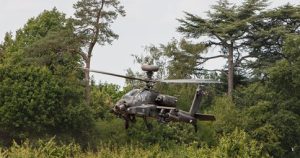 There is truly no rest for the wicked. Following the release of CPE v2.2, our participation in CNE 2023 and other related events and exercises, and concurrently with the preparations for CUE 2023, the Command dev team has been busy polishing the next major update for CMO. After an extended public beta period, the wait is over: CMO v1.06 is here. (Full release notes available HERE)
There is truly no rest for the wicked. Following the release of CPE v2.2, our participation in CNE 2023 and other related events and exercises, and concurrently with the preparations for CUE 2023, the Command dev team has been busy polishing the next major update for CMO. After an extended public beta period, the wait is over: CMO v1.06 is here. (Full release notes available HERE)
Undoubtedly the biggest single new feature of the new release is the transition to a 64-bit architecture, which resolves one of the biggest technical deficiencies of the system. But if is far from the only one:
* The map engine was ripped out and replaced with a new DirectX 11-based map renderer. This has provided significantly more headroom for improved zoom/pan performance, as well as reduced latency and increased throughput when rendering map layer tiles.
* A hot request from the player community: Weather and the day/night cycle affect air sorties. Non-all-weather aircraft are grounded at night or in bad weather.
* Target Priority Lists: Prioritize targets as part of doctrine settings. This makes it even easier to set up realistic targeting behaviors for the AI.
* Proximity-fuzed airburst round mechanics: Much more realistic modeling of proximity flak, a weapon/fuze type critical in WW2 and currently making a big comeback as a drone killer.
* Per-sensor mast height. Different horizon ranges and LOS clerances for different sensors on the same platform.
* Terrain type-dependent skyline / land-cover heights. Some units can fly between treelines or buildings, or pop their mast-mounted sensors above the local vegetation to get a clearer look of the battlefield.
* Decoy mobile platforms: Can use entire full-kitted platforms as realistic-looking decoys.
* Improved Sentinel-2 map layer: Crisper, hill-shaded, easier on the eyes and much more performant.
* Weapon-deployable platforms: For example, transport and launch child aircraft from parent aircraft (e.g. D-21 and WZ-8 recon drones).
* Latest sim database releases with thousands of additions and tweaks.
The development team is already busy putting together the next major CMO release (with another major feature that has long been a high request in the player base), while also preparing for the upcoming Command User Event in Rome. See you there in September!





